
About UsThe Numismatic Bibliomania Society is a non-profit association devoted to the study and enjoyment of numismatic literature. For more information please see our web site at coinbooks.org SubscriptionsThose wishing to become new E-Sylum subscribers (or wishing to Unsubscribe) can go to the following web page link MembershipThere is a membership application available on the web site Membership Application To join, print the application and return it with your check to the address printed on the application. Print/Digital membership is $40 to addresses in the U.S., and $60 elsewhere. A digital-only membership is available for $25. For those without web access, write to: Charles Heck, Treasurer
AsylumFor Asylum mailing address changes and other membership questions, contact Terry at this email address: terrywhite5475@yahoo.com SubmissionsTo submit items for publication in The E-Sylum, write to the Editor at this address: whomren@gmail.com BUY THE BOOK BEFORE THE COIN |
- WAYNE'S WORDS: THE E-SYLUM MAY 19, 2019
- NEW BOOK: THE HALF CENT, 1793-1857
- NEW BOOK: A GUIDE TO CASH COINS
- NEW BOOK: THE BANKNOTE BOOK: ARGENTINA
- NEW BOOK: 2019 CANADIAN TIRE CATALOGUE
- NEW BOOK: THE COLLECTOR'S HANDBOOK, 10TH ED.
- CHERRYPICKERS' GUIDE EDITORIAL SUMMIT
- N. NEIL HARRIS (1940-2019)
- TOKEN MAKER INGLE-SCHIERLOH RECORDS ON NNP
- VIDEO: NUMISMATIC NEWS EDITOR DAVID HARPER
- COUNTESS OF DURHAM, NOT FLORENCE NIGHTINGALE
- NOTES FROM E-SYLUM READERS: MAY 19, 2019
- ON DATING ARCHAEOLOGICAL SITES USING COINS
- MORE ON MAGICIAN PROFESSOR KING
- VOCABULARY TERM: CONVENTION BADGE
- ALONZO J. WHEELER (1805-1867)
- HARVEY STACK'S NUMISMATIC FAMILY, PART 44
- BOWERS ON COLLECTING: THE ANA AND THE ANS
- SOME INTERESTING MEDALS: MAY 19, 2019
- WAYNE'S NUMISMATIC DIARY: MAY 19, 2019
- RARE COIN OF ULPIUS CORNELIUS LAELIANUS FOUND
- ALTERED DATE "1880" SHIELD NICKEL
- U.S. MINT SUSPENDS MUTILATED COIN PROGRAM
- BETTING ON NICKELS
- VIETNAM TO SELL UNPOPULAR COINS AS SCRAP METAL
- 2019 HORNBY ISLAND MUNICIPAL TRADE TOKENS
- CARSON CITY COIN PRESS STRIKES RAILROAD MEDAL
- CYRUS-TRUMP PROCLAMATION COIN PROMOTED
- MORE ON WEST VIRGINIA'S UNCLAIMED MEDALS
- TURKEY'S GÖBEKLITEPE COMMEMORATIVE ZERO EURO
- FT HIGHLIGHTS BULGARI COIN JEWELLERY
- LOOSE CHANGE: MAY 19, 2019
- BIG BANG THEORY'S FAKE NOBEL PRIZE MEDAL
- FEATURED WEB SITE: CANADIAN TIRE COUPON COLLECTORS CLUB
Click here to access the complete archive a
Click here to unsubscribe (scroll down)
To comment or submit articles, reply to whomren@gmail.com
Content presented in The E-Sylum is not necessarily researched or independently fact-checked, and views expressed do not necessarily represent those of the Numismatic Bibliomania Society.
WAYNE'S WORDS: THE E-SYLUM MAY 19, 2019
 New subscribers this week include: Harry Rivera, J. Gosney, and Allen Pauly. Welcome aboard! We now have 5,925 subscribers.
New subscribers this week include: Harry Rivera, J. Gosney, and Allen Pauly. Welcome aboard! We now have 5,925 subscribers.
Thank you for reading The E-Sylum. If you enjoy it, please send me the email addresses of friends you think may enjoy it as well and I'll send them a subscription (but let me know if they are located in the European Union). Contact me at whomren@gmail.com anytime regarding your subscription, or questions, comments or suggestions about our content.
This week we open with five new books, and updates from Whitman Publishing and the Newman Numismatic Portal.
Other topics this week include editor of The Numismatist N. Neil Harris, retired Numismatic News editor Dave Harper, convention badges, the ANA and the ANS, an altered date Shield Nickel, the U.S. Mint's mutilated coin program, and Bulgari's coin jewellery. We won't discuss the Numismatic News Friday Edition headline "Are 1838-D Jefferson Nickels a Good Buy?", but it's too good a typo not to mention.
To learn more about Half Cents, cash coins, the Cherrypickers' Guide, coal scrip, the Countess of Durham, numismatic superheroes, collector Alonzo Wheeler, dealer Morton Stack, the Rutherford Gold Company, tobacco plantation tokens, and buyer's fee math, read on. Have a great week, everyone!
Wayne Homren
Editor, The E-Sylum
NEW BOOK: THE HALF CENT, 1793-1857
In March, Bill Eckberg gave us a preview of his new Half Cent book. The preorder period has passed and the book is now available. This is an important new work on the topic. If you're a member of NBS, ANA, EAC or C4, take advantage of your discount. See below for details. -Editor
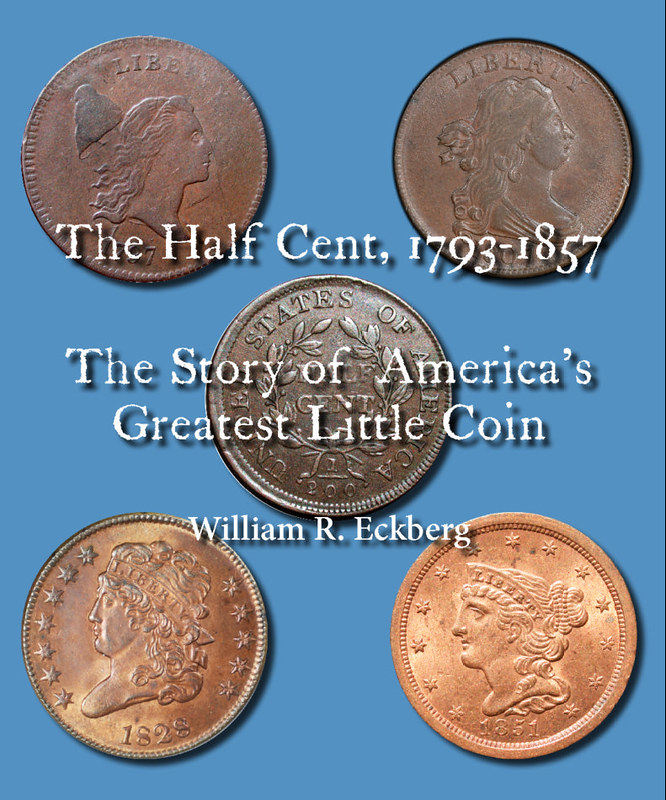 Early American Coppers (EAC) is proud to announce the May 1, 2019 publication of The Half Cent, 1793-1857: The Story of America's
Greatest Little Coin, by William R. Eckberg. EAC's second book, it is an important new reference on one of the first denominations coined by the
United States of America.
Early American Coppers (EAC) is proud to announce the May 1, 2019 publication of The Half Cent, 1793-1857: The Story of America's
Greatest Little Coin, by William R. Eckberg. EAC's second book, it is an important new reference on one of the first denominations coined by the
United States of America.
This book tells the story of the half cent from its antecedents and models through its first release in 1793 to its end in 1857. Why did we ever have such a small denomination, anyway? Who made them? When were they made? How many are known of each variety? How are the coins graded today? All of these questions and more are clearly addressed.
This hard cover book is 8½ x 11" and profusely illustrated in full color with high resolution photos. All business strike half cent obverses and reverses are illustrated by full color 3.5" photos.
Because of the way they were made, and because they were the money of the people, half cents have a charm and character that few other denominations can have, and this charm and interest come through clearly in the book.
Eckberg says he wrote the book because much new research about the coins' design, engraving and manufacture has been developed since the Cohen and Breen books of 35 years ago, and that has allowed him to correct a number of misconceptions about the series and other early coins of the U.S. Mint. This research, much of it by the author, has come from the study of early Mint documents and the coins themselves. His study of the early half cents' manufacture has provided important new insights into the operation of the early U.S. Mint and into how other denominations were created as well.
Dr. Harry E. Salyards, editor of Penny-Wise, the quarterly journal of EAC, writes: "until now, the half cent has lacked an author able to write in an engaging conversational style while incorporating solid research evidence. As a trained scientist and lifelong teacher, Bill Eckberg is well suited to become the first to do so. Among the literature of early American copper as a whole, we have had homey narratives littered with pseudoscience, and ex-cathedra pronouncements aplenty. We have also had way too much 'history' written in the past subjunctive: narratives introducing each unsupported assertion with a phrase such as, 'Surely there would have been. . .'
"You will find none of that sort of thing here. What you will find is the voice of an enthusiastic collector who has made some unexpected discoveries over the course of his thirty years' pursuit of the American half cent-a fascinating and still underappreciated series."
Every collection of U.S. coins should contain at least a few half cents. Scarcer as a denomination than the key Lincoln cent, the 1909-S VDB, they are truly rare coins. Yet, most half cents are remarkably affordable to the average collector. A U.S. series that is both rare and affordable? Yes! Still, most collectors only know them as type coins, if at all. This book will serve as an interesting and informative introduction to the series for those who are unfamiliar with it and will provide enough new knowledge to satisfy even the most advanced specialists.
The book is available from http://halfcentbook.com . The cover price is $125, but members of EAC, Colonial Coin Collectors Club, Numismatic Bibliomania Society and the American Numismatic Association may order it for $95 plus shipping. For quantities of 10 or more, please contact halfcent@icloud.com. The print run is limited to 500 copies plus 10 in a special hand-bound edition in black leather.
Mini-Review
Here's an early report from Ray Williams, former President of the Colonial Coin Collectors Club (C4). -Editor
At EAC Dayton, I purchased the new Half Cent book By Bill Eckberg. I did so not because of an interest in Half Cents, but because the author is a friend. The title is The Half Cent 1793-1857 The Story of America's Greatest Little Coin. The book sat in my car for 10 days after returning from Dayton, along with all the other A/V equipment and table supply boxes. I sat down this afternoon with a little time to kill, and opened the book. The preface reminded me a bit of how Sheldon hooked me with his description of making out the old coppers at the kitchen table. Bill hooks the reader by his relating his early collecting experiences.
Before the beautifully photographed descriptions of all the die varieties, Bill covers all the aspects of Half Cents that a collector (I) would want to know.
What really makes the book are two awesome coins plated on page 16! (mine - LOL!) But seriously, the author has replaced Cohen numbers with alpha-numeric die variety designations, which follow die emission sequence.
With Vermont Coppers, Ryder designated die varieties with numbers, just as Cohen did with the Half Cents. Ken Bressett reclassified Vermont varieties by numbering obverses and lettering reverses. Because Ryder varieties were familiar to all, it's taking way too long for the more accurate Bressett varieties to take over. It is my sincere hope that the Eckberg variety system is accepted in a timely manner with catalogers, collectors & grading services.
I'm happy I purchased the book and will attempt to attribute the few Half Cents I've found metal detecting, and maybe I might look to buy a Half Cent when I get to the GSNA Convention going on right now. Oh... If you want to know more about this book, check out: halfcentbook.com
For more information, or to order, see:
http://halfcentbook.com
To read the earlier E-Sylum article, see:
NEW BOOK: THE HALF CENT, 1793-1857
(https://www.coinbooks.org/v22/esylum_v22n10a02.html)
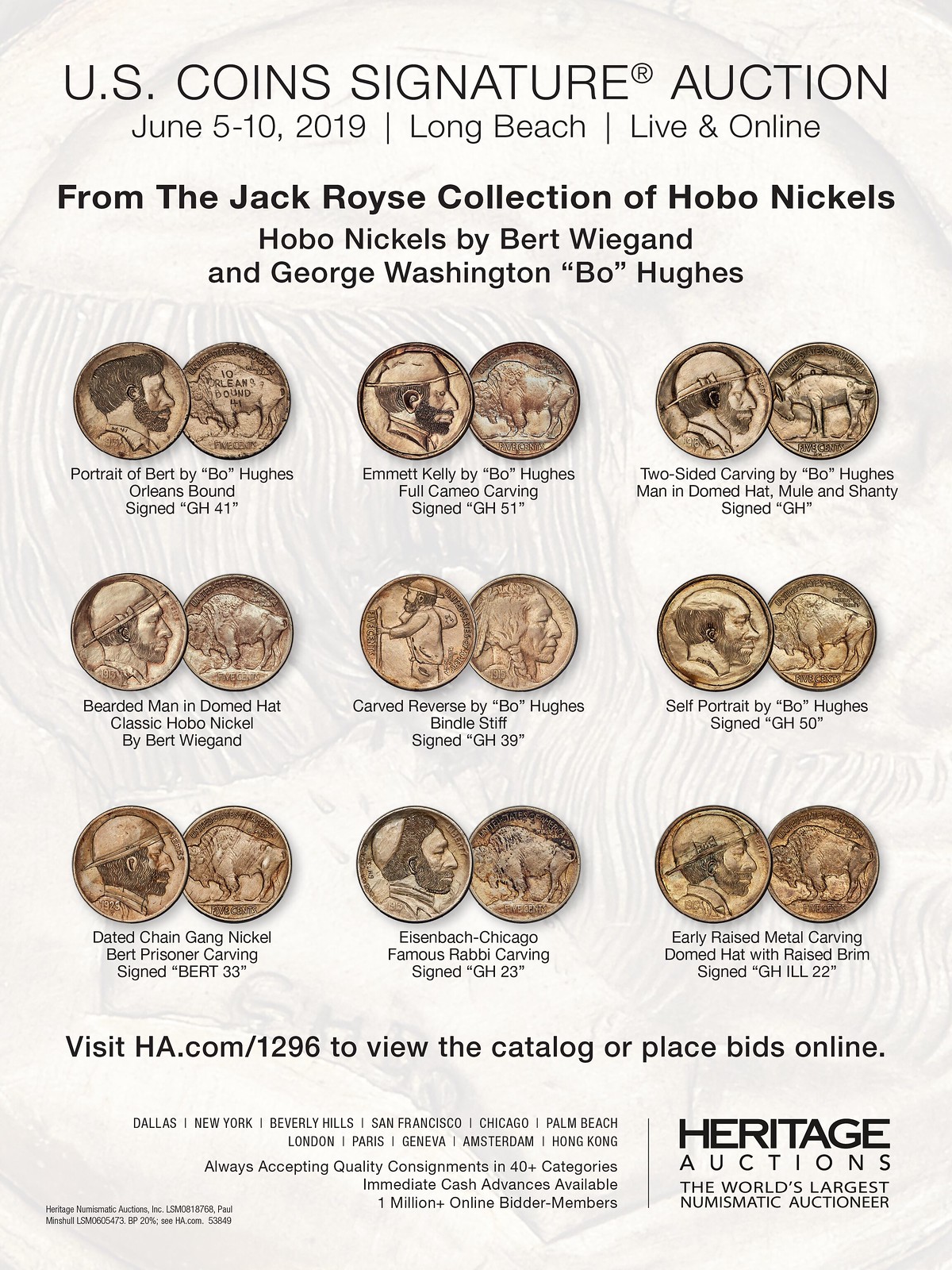
NEW BOOK: A GUIDE TO CASH COINS
David Hartill has published a new book on cash coins. -Editor
 This book is intended to guide the beginner and expert through the many kinds of cash - the square-holed coin of China for centuries -
produced in China and the many imitations of them produced at various times all over the Far East and along the Silk Road. The first part of the book
is a Finding Guide which directs the reader to the appropriate standard work on Chinese, Vietnamese, Japanese or Korean coins. In the second half,
information not in the standard works is presented, either from other publications and papers, or from the author's own research.
This book is intended to guide the beginner and expert through the many kinds of cash - the square-holed coin of China for centuries -
produced in China and the many imitations of them produced at various times all over the Far East and along the Silk Road. The first part of the book
is a Finding Guide which directs the reader to the appropriate standard work on Chinese, Vietnamese, Japanese or Korean coins. In the second half,
information not in the standard works is presented, either from other publications and papers, or from the author's own research.
Title: A Guide to Cash Coins
Paperback: 252 pages
Publisher: New Generation Publishing (February 24, 2017)
Language: English
ISBN-10: 1787192997
ISBN-13: 978-1787192997
Product Dimensions: 8.3 x 0.5 x 11.7 inches
Shipping Weight: 1.5 pounds
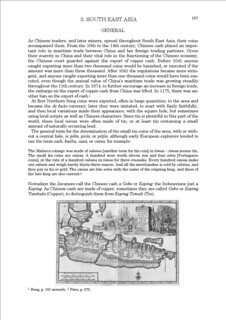
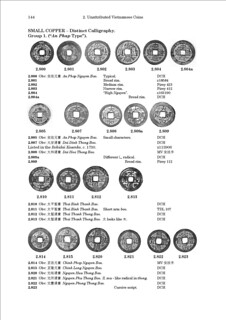
For more information, or to order, see:
A Guide to Cash Coins Paperback - February 24,
2017 (https://www.amazon.com/Guide-Cash-Coins-David-Hartill/dp/1787192997/ref=sr_1_fkmrnull_1)
NEW BOOK: THE BANKNOTE BOOK: ARGENTINA
Owen Linzmayer announced the availability of the latest chapter of The Banknote Book, a comprehensive catalog of the notes of Argentina. -Editor
 We're very pleased to announce that the Argentina chapter is now available for individual sale and as a free download to subscribers.
Special thanks goes out to co-author Jari Heine, who was a great help in completing the detailed coverage of this complex country.
We're very pleased to announce that the Argentina chapter is now available for individual sale and as a free download to subscribers.
Special thanks goes out to co-author Jari Heine, who was a great help in completing the detailed coverage of this complex country.
Argentina (South America)
This 83-page catalog covers notes issued by the Banco Nacional (National Bank) from 1884 to 1891, the Caja de Conversión (Conversion Fund) from
1891 to 1935, and the Banco Central de la República Argentina (Central Bank of the Republic of Argentina) from 1935 to present. Published
17.05.2019.
For more information, or to order, see:
http://banknotebook.contentshelf.com/shop
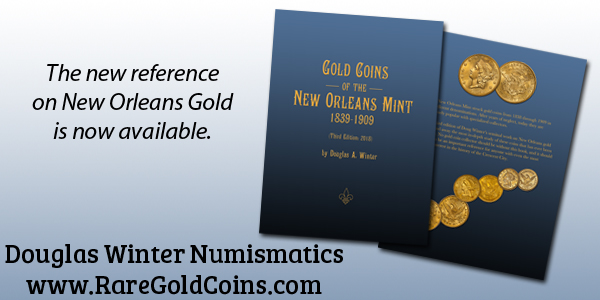
NEW BOOK: 2019 CANADIAN TIRE CATALOGUE
The Canadian Tire Coupon Collectors Club has published a new edition of their catalog of Canadian Tire Money and associated coupons. -Editor
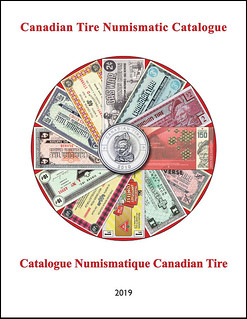 The 2019 Canadian Tire Numismatic Catalogue contains all the regular issues of notes issued by the Corporation, the Petroleum division and
Simard-Montcalm. The large majority are made by Canadian Banknote Company and British American Bank Note. This new edition is a complete renewal and
now includes over 1200 Canadian Tire numismatic items.
The 2019 Canadian Tire Numismatic Catalogue contains all the regular issues of notes issued by the Corporation, the Petroleum division and
Simard-Montcalm. The large majority are made by Canadian Banknote Company and British American Bank Note. This new edition is a complete renewal and
now includes over 1200 Canadian Tire numismatic items.
The catalogue numbers have been upgraded to facilitate electronic sorting with as little impact as possible on the original numbering system. All major varieties have been added. If you have a major variety that is missing let us know and we will get it into next years revision.
All notes issued until the end of February 2019 are included.
There are nearly 1000 images describing the notes. This catalogue is in color and the format is 8.5" x 11" and has 140 pages.
Due to a change in the printing process, the catalogue is now available in full colour at a reasonable price.
For more information, or to order, see:
2019 Canadian Tire Numismatic Catalogue - Printed
Copy $50.00 (https://ctccollector.ca/store/shop/2019-canadian-tire-numismatic-catalogue-printed-copy/)
2019 Canadian Tire Numismatic Catalogue -
Downloadable $12.00 (https://ctccollector.ca/store/shop/2018-canadian-tire-numismatic-catalogue-downloadable-copy/)
NEW BOOK: THE COLLECTOR'S HANDBOOK, 10TH ED.
 Martin Kaplan sent a link to an Ivy Press publication available through Heritage. First produced in 2000 under the title The Rare Coin
Estate Handbook, this guide to estate tax planning is in its 10th edition. Written by James L. Halperin, Gregory J. Rohan and Mark J.
Prendergast, it was edited for 2016 by Mark Prendergast, Noah Fleisher, Meredith Meuwly and Steve Roach. It's available free online at the link
below; hardcopies are also available for purchase.
Martin Kaplan sent a link to an Ivy Press publication available through Heritage. First produced in 2000 under the title The Rare Coin
Estate Handbook, this guide to estate tax planning is in its 10th edition. Written by James L. Halperin, Gregory J. Rohan and Mark J.
Prendergast, it was edited for 2016 by Mark Prendergast, Noah Fleisher, Meredith Meuwly and Steve Roach. It's available free online at the link
below; hardcopies are also available for purchase.
It opens with a classic quote from the will of Edmond de Goncourt, one that I wholeheartedly agree with (though I haven't let it completely stop me from making donations of material to museums and libraries). -Editor
"My wish is, so that my drawings, my prints, my
curiosities, my books, in a word, those things of
Art which have been the joy of my life shall not
be consigned to the cold tomb of a museum, and
subjected to the stupid glance of the careless
passer-by; but I require that they shall all be
dispersed under the hammer of the auctioneer,
so that the pleasure which the acquiring of each
one has given to me, shall be given again, in
each case, to some inheritor of my own tastes."
From the will of Edmond de Goncourt, 1896
Here's an excerpt from the Foreword. -Editor
My friend John Jay Pittman did not start out a wealthy man. Slowly and with dedication, he assembled an incredible coin collection. He accomplished this through relentless study and the devotion of a significant portion of his limited income as a middle manager for Eastman Kodak, supplemented by his wife's income as a schoolteacher.
In 1954, he mortgaged the family house to travel to Egypt and bid on coins at the King Farouk Collection auction, and he demanded many more sacrifices of himself and his family over the decades. He passed away in 1996 with no apparent regrets, and his long-suffering family deservingly reaped the rewards of his efforts when the collection was sold at auction for more than $30 million.
But why did he do it?
On our website, HA.com, we auction many different types of collectibles; what started in 1976 as a numismatics business is now the third-largest auction house in the world - with annual sales exceeding $850 million in 2015 in categories ranging from meteorites to Hermès handbags. Most of our 950,000+ registered client/bidders collect in more than one area, which we can determine through online surveys, free catalog subscriptions, and multiple drawings for prizes throughout the year. Our clients seek many different collecting areas, and for many different reasons.
One fervent collector of historical documents refers to his passion as "a genetic defect." The founding father of psychoanalysis Sigmund Freud, a renowned collector in his own right, thought that collecting was really about sex: "The core of paranoia is the detachment of the libido from objects," he wrote in 1908. "A reverse course is taken by the collector who directs his surplus libido into an inanimate object: a love of things." But more likely it's basic human instinct: a survival advantage amplified by eons of natural selection. Those of our ancient ancestors who managed to accumulate scarce objects may have been more likely to survive long enough to bear offspring-and people who owned shiny objects may have had an easier time attracting mates. Even today, wealth correlates with longer life expectancy; and could any form of wealth be more primal than scarce, tangible objects?
While the thrill of the hunt and a passion for objects-whether it's Lithuanian first-day covers or Alberto Vargas paintings-is what motivates and excites collectors, there are, alas, some housekeeping chores that must be attended to in order to assure that you derive the most benefit from your collection. Whether that means minimizing your tax burden, ensuring that your objects are safe from intruders, or maximizing your collection's value for your heirs, a little attention now can save you a massive headache later.
The book is a delight to read, something you certainly wouldn't expect from an estate planning guide. There are great true-story anecdotes from collectors and their families that will make you laugh out loud, cringe, or both. Dumb luck, bad ideas, and insufficiently precise grammar all play a role. Check it out. -Editor
To read the complete book, see:
The Collector's Handbook: Tax Planning, Strategy and Estate Advice for Collectors and
Their Heirs (https://www.ha.com/c/ref/handbook.zx?src=download)

CHERRYPICKERS' GUIDE EDITORIAL SUMMIT
Dennis Tucker of Whitman Publishing submitted this report on a recent meeting to plan the next edition in the Cherrypickers' Guide series. Thanks. I added the image of the fifth edition cover. -Editor
Whitman Publishing Holds Cherrypickers' Guide Editorial Summit in Chattanooga
 An editorial summit was convened in Chattanooga, Tennessee, May 1 and 2, 2019, to plan the sixth edition, volume II, of Whitman
Publishing's Cherrypickers' Guide to Rare Die Varieties of United States Coins. The meeting laid out a comprehensive plan for updating the
volume, which covers die varieties of U.S. coins from half dimes to gold double eagles, plus commemoratives, bullion, and other series. It will be
published in 2020, marking the 30th anniversary of the Cherrypickers' Guide.
An editorial summit was convened in Chattanooga, Tennessee, May 1 and 2, 2019, to plan the sixth edition, volume II, of Whitman
Publishing's Cherrypickers' Guide to Rare Die Varieties of United States Coins. The meeting laid out a comprehensive plan for updating the
volume, which covers die varieties of U.S. coins from half dimes to gold double eagles, plus commemoratives, bullion, and other series. It will be
published in 2020, marking the 30th anniversary of the Cherrypickers' Guide.
Present at the conference were Cherrypickers' Guide coauthor Bill Fivaz; Whitman publisher Dennis Tucker and associate editor Brandon C. Hall; and professional numismatist Larry Briggs, who is coordinating edits and updates for the sixth edition, volume II. They met at the headquarters of SEGS Grading Service in Chattanooga.
To "cherrypick" is to examine coins that appear normal at first glance and find ones that have unusual characteristics-doubled and tripled dies, overdates, repunched mintmarks, and similar features-that reveal them to be rare and valuable. The Cherrypickers' Guide uses close-up photographs and text descriptions to guide collectors in what to look for. It includes rarity ratings and values.
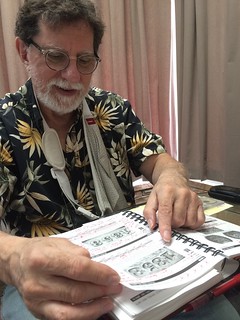
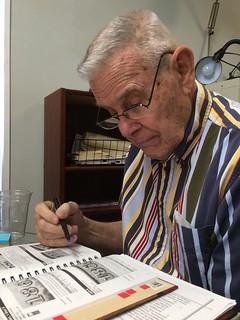
Larry Briggs and Bill Fivaz
The sixth edition, volume II, is expected to include more than 800 die varieties, including many new additions. It will cover Capped Bust coinage from half dimes through half dollars; Liberty Seated coinage; Barber silver coins; and every modern series from the early 1900s to date, plus gold dollars through $20 gold coins, classic commemoratives, and modern bullion pieces.
"Many coin series will be expanded, and there will be several entirely new sections," said Tucker. "This volume includes some of the most popular U.S. coin types, including Mercury and Roosevelt dimes, Washington quarters, Liberty Walking half dollars, Franklin and Kennedy half dollars, Morgan and Peace silver dollars, and modern dollar coins."
In the coming weeks and months the book's editors will reach out to the hobby community for advice, recommendations, and research. In the meantime, they can be contacted by email at cherrypickers@whitman.com.

Dennis Tucker, Bill Fivaz, Larry Briggs
and Whitman associate editor Brandon C. Hall
Coauthor Bill Fivaz, a coin collector since 1950, has earned recognition as one of the country's most respected authorities on numismatic errors and die varieties. He is a longtime contributor to the Guide Book of United States Coins (the "Red Book"). With the late J.T. Stanton he coauthored the first Cherrypickers' Guide in 1990, launching the modern boom in interest in die varieties.
Larry Briggs is well known to the hobby community as a dealer, author, and educator. He served the American Numismatic Association as president of its Authentication Committee. A student of history and archaeology, Briggs served in the U.S. Air Force and worked for Ford Motor Company before launching his own business, Larry Briggs Rare Coins, in 1978. His specialties include error coins and die varieties, Liberty Seated coinage, and early American coppers.
Cherrypickers' Guide to Rare Die Varieties of United States Coins, sixth edition, volume II.
By Bill Fivaz and J.T. Stanton; forewords by Kenneth Bressett and Q. David Bowers; edited by Larry Briggs.
Publication date: 2020. Retail price, page count, and other details to be announced.
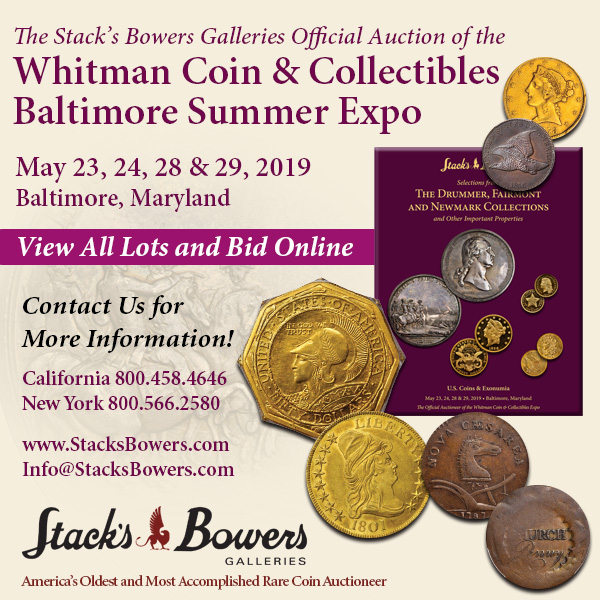
N. NEIL HARRIS (1940-2019)
I was sorry to learn this week that N. Neil Harris passed away on Saturday, May 11th, 2019. Neil was editor of the American Numismatic Association publication The Numismatist from January 1974 through June 1988.
Neil was a sculptor and illustrator whose medallic work is cataloged in Dick Johnson's databank (linked below). He also wrote the catalog of ANA's convention medals and edited Robert Julian's Medals of the United States Mint, The First Century 1792-1891.
Pete Smith provided this sketch on Neil by Bill King from his "Who's Who in the Hobby" series as published in Numismatic News December 26, 1972. -Editor
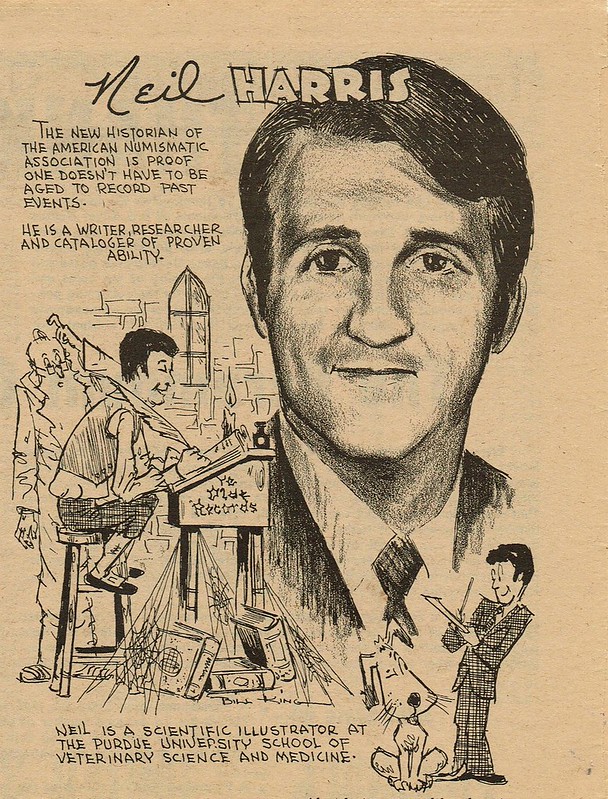
To read Dick Johnson's databank entry on N. Neil Harris, see:
HARRIS, N. Neil (1940- ) sculptor, medalist, illustrator, editor, author.
(http://www.medalartists.com/harris-n-neil.html)
To read Pete Smith's biography on the Newman Numismatic Portal, see: N. Neil Harris (https://nnp.wustl.edu/library/PersonDetail/918)

TOKEN MAKER INGLE-SCHIERLOH RECORDS ON NNP
The latest additions to the Newman Numismatic Portal are records of token manufacturer Ingle-Schierloh. Project Coordinator Len Augsburger provided the following report. Thanks. -Editor
Records of Ingle-Schierloh, Token Manufacturer, on Newman Portal
 The Ingle-Schierloh Company, a Dayton, OH token manufacturing concern, did business with hundreds of coal mining (and other) companies in
the early 20th century. Collector Billy Campbell acquired unique, old records of Ingle-Schierloh and has made these available to Newman Portal. The
series consists of a main ledger, followed by 11 notebooks which arrange company correspondence alphabetically, by the city of the token-issuing
company.
The Ingle-Schierloh Company, a Dayton, OH token manufacturing concern, did business with hundreds of coal mining (and other) companies in
the early 20th century. Collector Billy Campbell acquired unique, old records of Ingle-Schierloh and has made these available to Newman Portal. The
series consists of a main ledger, followed by 11 notebooks which arrange company correspondence alphabetically, by the city of the token-issuing
company.
Combined with the comprehensive token cataloging provided by the site tokencatalog.com, collectors of these pieces can now access, online, images of the tokens in addition to the correspondence related to their manufacture. This provides a heretofore unavailable end-to-end view of these numismatic objects and enables further research on the subject.
The community aspect of Newman Portal allows individuals to contribute such content to a centralized repository, and Newman Portal acknowledges Billy Campbell for sharing these records with the wider numismatic community. Depicted here, courtesy of tokencatalog.com, is a 1-cent cutout token issued by the C. H. Mead Coal Company of East Gulf (WV).

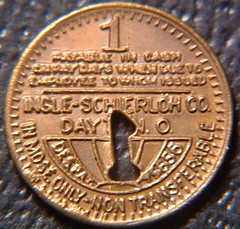
Obverse: C.H. MEAD COAL CO. / 1 / EAST GULF / NO 1 STORE
Reverse: 1 / PAYABLE IN CASH / ON PAY DAYS WHEN DUE TO / EMPLOYEE TO WHOM ISSUED / INGLE-SCHIERLOH CO. / DAYTON, O. / DES. PAT. 75656 / IN MDSE. ONLY NON TRANSFERABLE ("1" cutout)
Image: Order from C. H. Mead Coal Company for "master metal scrip," from vol. 4 of the Ingle-Schierloh records on Newman Portal
Link to Ingle-Schierloh archives on Newman Portal:
https://nnp.wustl.edu/library/archivedetail/531624
VIDEO: NUMISMATIC NEWS EDITOR DAVID HARPER
These are selections from the David Lisot Video Library that feature news and personalities from the world of coin collecting. David has been attending coin conventions since 1972 and began videotaping in 1985. In 2017 the Newman Numismatic Portal reached an agreement to list all David's videos on their website. Each week an excerpt of a different video is available on the CoinTelevision YouTube channel.
Here's one on the retirement of Numismatic News editor David Harper. -Editor
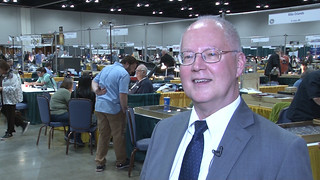 David Harper has decided to retire after more than 40 years with Krause Publications and "Numismatic News". Hear why David is retiring, his
memories of the Central States Convention and more.
David Harper has decided to retire after more than 40 years with Krause Publications and "Numismatic News". Hear why David is retiring, his
memories of the Central States Convention and more.
The entire interview is available on the Newman Numismatic Portal at:
https://nnp.wustl.edu/library/multimediadetail/522852
An excerpt of the video is available for viewing on the Coin Television YouTube Channel at:
https://youtu.be/hNjdv6bhWgg
David Harper Retires from Numismatic News. VIDEO: 3:58.
David C. Harper, Former Editor, Numismatic News, David Lisot, Interviewer, CoinTelevision.com.
This video is a highlight from the Central States Numismatic Society Convention held May 24-27, 2019.
CSNS Coin Convention Highlights 2019
Mitch Ernst, President, Kevin Foley, Bourse Chairman, Central States Numismatic Society, David Lisot, Interviewer, CoinTelevision.com.
This was the 80th annual convention for the Central States Numismatic Society. David Lisot brings highlights of the show with interviews including
Kevin Foley and why CSNS 2019 Coin Convention in Schaumburg Continues to Draw Collectors and Dealers, Thomas Uram Announces Plans to Run for American
Numismatic Association Vice-President, Chris Bulfinch New Numismatic Reporter for Coin World, a Father-Son Team Shares Passion for Coin
Collecting, Wooden Nickels at CSNS Convention and more.
CSNS19-005
The entire video is also available on DVD.
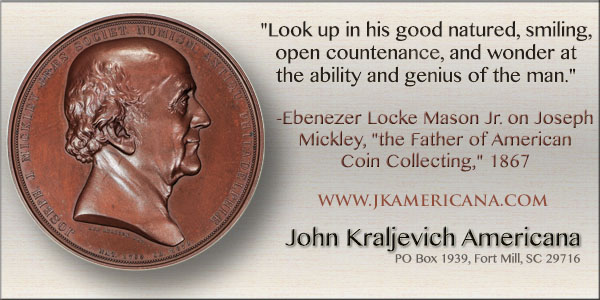
COUNTESS OF DURHAM, NOT FLORENCE NIGHTINGALE
Mark D. Tomasko (author of Images of Value, the Artwork Behind US Security Engraving 1830s-1980s) submitted this information on the identity of an American Bank Note Company female portrait. Thank you! -Editor
It's not Florence Nightingale
 I have been intending to write an article for one of the paper money journals about a female portrait done by American Bank Note Company,
because the portrait has for years been described as depicting Florence Nightingale, a description repeated in last week's E-Sylum.
I have been intending to write an article for one of the paper money journals about a female portrait done by American Bank Note Company,
because the portrait has for years been described as depicting Florence Nightingale, a description repeated in last week's E-Sylum.
What made me curious about the portrait, engraved by James Bannister in the earliest years of American Bank Note's existence (and therefore used on various obsolete bank notes), is that it didn't look like Florence Nightingale. A quick online search shows only one picture of the young Florence Nightingale (who is usually shown as an older woman) that bears any resemblance to ABN portrait no. 151 (old series).

So who is it? Fortunately American Bank Note engraving records provide the answer. It is the Countess of Durham. She was originally Lady Beatrice Hamilton, and after marrying George Frederick D'Arcy Lambton, the Second Earl of Durham, became the Countess of Durham. The Wikipedia entry for George Lambton describes her as having married George in 1854, after which she had thirteen children, and died in 1871, at the age of 35, just three days after the birth of her last child. Passing away at the age of 35 after having 13 children is both remarkable and sad.
Since there is no title on the die, and it is not a "Special" (i.e., engraved and paid for by one customer for their exclusive use), the portrait appears to have been engraved solely to add a "Fancy Head" (the bank note industry name for a decorative female head) to ABN's engraving stock.
If readers would like to see a very nice pastel of the lady, as well as a print of the image that was engraved by James Bannister, use the links
below.
http://www.nationaltrustcollections.org.uk/object/1270651
https://www.geni.com/people/Lady-Beatrix-Lambton-Countess-of-Durham/6000000007864389471
To read earlier E-Sylum articles, see:
FLORENCE NIGHTINGALE ON OBSOLETE PAPER MONEY
(https://www.coinbooks.org/v22/esylum_v22n19a07.html)
NEW BOOK: IMAGES OF VALUE (https://www.coinbooks.org/v20/esylum_v20n09a03.html)

NOTES FROM E-SYLUM READERS: MAY 19, 2019
Minnesota Numismatist on National Television
Pete Smith of Minneapolis writes:
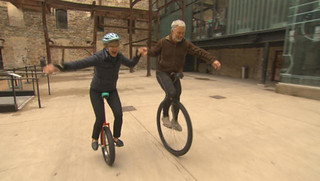 On Friday, May 17, CBS Television broadcast "No Exit" hosted by Jane Pauley. The show discussed traffic congestion and some
commuting alternatives. One segment featured Dan Hansen who regularly commutes to work on a unicycle.
On Friday, May 17, CBS Television broadcast "No Exit" hosted by Jane Pauley. The show discussed traffic congestion and some
commuting alternatives. One segment featured Dan Hansen who regularly commutes to work on a unicycle.
Dan is a Minnesota numismatist and E-Sylum subscriber. He took his unicycle to Philadelphia last year for the World's Fair of Money. He went out one morning around 3:00 A.M. to tour the streets of Philadelphia without traffic congestion.
The attached photo shows Dan with CBS correspondent Susan Spencer in the courtyard of the Mill City Museum where Dan works in downtown Minneapolis.
U.S. Auction Houses Collecting Sales Taxes
David Gladfelter writes:
I'm sure readers have noticed that U.S. auction houses are beginning to collect sales taxes on purchases made by successful bidders (unless the bidders have resale permits that exempt them from the taxes).
Some of them are improperly charging sales tax on U. S. Post Office shipping charges.
States lack the power to tax the Federal government or its agencies. Have you ever been charged sales tax when buying postage stamps? The reason that you're not charged is because of this lack of State power.
If an auction house uses a private shipper such as UPS or FedEx, a sales tax on that shipper's charge is proper. It is not proper on a U. S. Post Office charge.
Sales tax is proper on the hammer price, the buyer's premium, and the auction house's charge for packing. Some of the auctioneers absorb the packing charge as part of the BP, others charge separately.
I recalculate invoices that are improperly itemized.
Interesting nuance! Thanks for the background - this could save our readers some money. -Editor
One Big Coin Press
Mary Lannin writes:
This is a coin press that struck the first medal commemorating the founding of Belgium. When the Galeries Royales Saint-Hubert were built in 1846-1847, the coin press was too big to be moved, so they built the arcade around it....it's now a restaurant and wine bar!
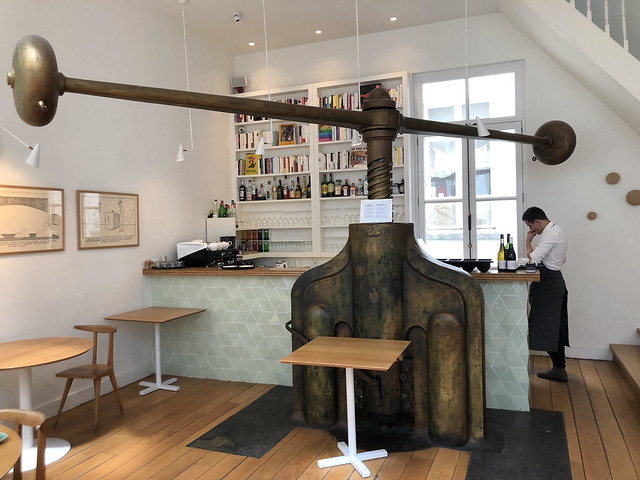
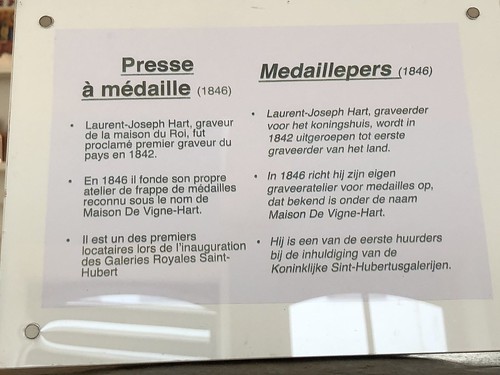
Sign text (in French)
Very cool! Thanks to Mary for the text and photo, and Tom Uram for suggesting publishing it here. What a beast! -Editor
Roger Dewardt Lane Contact Sought
Alan Luedeking writes:
I would like to contact Roger Dewardt Lane, author of the excellent book Brother Can You Spare A Dime? - Modern Dime Size Silver Coins of the World with a research question about some information in the book that I have not been able to track down anywhere else. Unfortunately, Mr. DeWardt Lane's only known email address has gone quiet. If anybody has a phone number or known good email address for Roger, it'd be appreciated.
Can anyone help? -Editor
To read the earlier E-Sylum article, see:
ENCYCLOPEDIA OF SMALL SILVER COINS BY ROGER DEWARDT LANE
(https://www.coinbooks.org/esylum_v10n42a03.html)
More on the Ft. Ross, California Souvenir Token
Web site reader Bernard Macy writes:
You don't know me, but you probably saved me more than $90 today! I found an item in an online auction with the headline: "Extremely Rare 1700s Siberian Coin Fort Ross". The estimate for the coin was more than a few hundred dollars. I bid $80 on it, plus a hefty premium. After the bid hit my maximum amount, I decided to do more research. (My initial work proved to be quite poor!)
Fortunately, I found your articles. After reading the first one, I contacted the auction company. Equally fortunately, the gracious representative immediately removed my bid. Thank you, Wayne!
Continued success with your numismatic efforts.
Readers Phil Mernick, Dick Hanscom, and Steve D'Ippolito are the true heroes here - thanks for submitting the information! We're very happy to publish it for the benefit of future collectors. -Editor
To read the earlier E-Sylum articles, see:
THE FT. ROSS, CALIFORNIA SOUVENIR TOKEN
(https://www.coinbooks.org/esylum_v17n25a16.html) MORE ON THE FT. ROSS, CALIFORNIA SOUVENIR
TOKEN (https://www.coinbooks.org/esylum_v17n26a17.html)
... and 20 Years After You're Dead
Jud Petrie writes:
Regarding the good luck token 'and 20 years after you're dead', this is a magic token as well, the reverse of a Balante 'Mr Hypnosis' token issued in 1968, probably in Canada. As you didn't depict the other side, here is MT030.100 in Paul Corville's magic token reference update.

I was having trouble accessing the website where I found the token, so I just published what I had. Yes, it was a Magic site. Thanks for the image and background! -Editor
To read the earlier E-Sylum article, see:
NUMISMATIC NUGGETS: MAY 12, 2019 : A Long-Lasting Good Luck Token
(https://www.coinbooks.org/v22/esylum_v22n19a18.html)
Numismatist Superhero Cartoon
Several readers spotted this Pearls Before Swine cartoon by Stephan Pastis, which was published nationally on May 16, 2019. Thanks to Steve Bishop, Bob Evans, Dick Hanscom, Tom Sheehan, and Ray Williams. -Editor

And speaking of cartoons, Jeffry Johnson passed along the URL of the original Glasbergen cartoon submitted by Dick Johnson last week. Thanks. -Editor
To read the cartoon online, see:
https://www.glasbergen.com/wp-content/gallery/kid-cartoons/Toon-12252.gif
To read the earlier E-Sylum article, see:
NOTES FROM E-SYLUM READERS: MAY 12, 2019 : Read A Book!
(https://www.coinbooks.org/v22/esylum_v22n19a10.html)
On Pranking Archaeologists With Salted Coins
Dick Hanscom of Alaska writes:
As to George's suggestion, I thought of dropping a few ancient Roman in an archaeological dig in Fairbanks year ago. Never got around to it.
Paul Schultz writes:
Regarding the comment last week that: "Wouldn't it be fun, and good PR, for coin collectors to 'salt' various old coins in unlikely locales?" I think it is a very bad idea in the long run. Archaeologists depend heavily on coins to date old sites, and get an idea of who was doing what there at the time. Imagine if random old coins started turning up in odd old locations-it would destroy the credibility of coins as useful dating and societal indicators, since there would always be the doubt that the coins could be salted. It would make a lot of publicity for a few months, but it may not turn out to be good publicity in the end. It would destroy a valuable archaeological tool for serious investigations and discredit collectors.
It is bad enough that some archaeologists dislike people removing coins from old sites, but then adding extraneous coins to a wide variety of sites would completely destroy the utility of coins to historical investigations. Just read the later article on how an Australian coin find could be from Africa. What value would there be in this investigation if the question were raised whether someone salted the area 5 years ago?
Numismatists and archaeologists have differing approaches and don't always see eye-to-eye on common issues. While I could see the fun in a targeted prank I would never do it myself and would not condone it on a larger scale. Better all around to stick to facts and science. See the submission by Gary Beals in this issue for a discussion of the science behind dating the burial of old coins. -Editor
To read the earlier E-Sylum articles, see:
UTAH SPANISH COIN FIND PUZZLES PARK SERVICE
(https://www.coinbooks.org/v22/esylum_v22n17a23.html)
Mystery of the Spanish
coins that predate Christopher Columbus by 200 years and have been found deep in the Utah desert
(https://www.dailymail.co.uk/news/article-7009641/Mystery-Spanish-coins-Utah-desert-predate-Columbus-200-years.html)
AUSTRALIAN COIN FIND COULD BE FROM AFRICA
(https://www.coinbooks.org/v22/esylum_v22n19a21.html)

ON DATING ARCHAEOLOGICAL SITES USING COINS
Gary Beals, author of Numiscadero, the Spanish/English numismatic dictionary submitted these thoughts on dating archaeological sites using coins as evidence. -Editor

"A hiker in southern Utah has found what appear to be old Spanish coins possibly dating back to the time of the conquistadors and perhaps even earlier, long before the voyages of Columbus."
There are some gaps here as many readers have already noted. Suspicion abounds regarding the unidentified tourist who found two Spanish copper coins. So far, there is not much journalistic detective work going on. First of all, just exactly where and how did this hiker find these coins? The park management is not talking, so far. And who is the hiker?
The Spanish 16 maravedis coin from the 1600s could have come from Spain in the pocket of some explorer centuries ago - but that is highly unlikely. The medieval dinero burguese the smallest denomination from King Alfonso X's reign in Castilla y Leon of about 1280 is another story. No way it could have been loose change even here in Spain in the 1600s. Too many governments and monetary systems have been in use since it was issued. Both coins appear to have been buried long ago and since been in a protected environment. That's a clue to what has occurred here.
Exactly where were these coins found? By that I mean were they in a dry cave? It does not seem like they could have spent decades out in the wild open countryside. Some clues: The coins have not been exposed to much weather in recent years, in my opinion. The numismatic value of the two coins is perhaps $30. Both coins appear to be genuine - either is a type worth faking. The low numismatic value makes tomfoolery more likely, however. As was already suggested, the idea of a bit of historical horseplay is quite possible here. Because I am a serious numismatist but also a recovering smart-ass, I know it would be great fun to pull tricks on people with old coins.
I would like to focus my comments and questions on coin damage created by burial or being hidden away in some manner. Patina tells us a lot about what a coin has been doing as the decades roll by. I am no specialist on coin corrosion but the topic is interesting. This quick report poses more questions than answers.
CASE STUDY
This copper coin strip shows how burial in dirt can wreck rare items. Here are photos of each side - one worse than the other. This Segovia roller
dies mint strip was created in 1662 and tossed into the weeds along with many others by mint workers. It was underground from then until 2014 when
archaeologists excavated the dirt near the mint. They missed finding this piece, but with the help of my metal detector I found it. I followed the
dump trucks to the land fill where the abandoned dirt was piled. This curved strip is an example of one side of the coin being heavily corroded and
the other side less harmed. Which side was up and which was down I leave to a specialist, but after 352 years in ground which received rain and snow
every year, the difference in damage is dramatic.
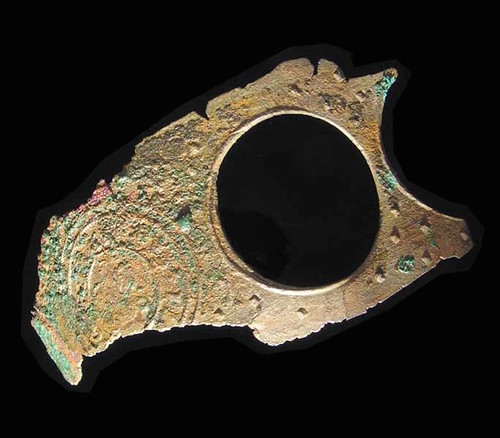
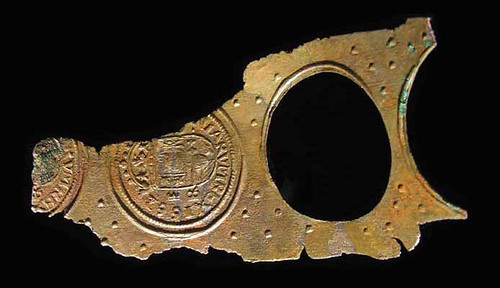
CASE STUDY
Here is a coin I found a few years ago in dirt from the basement of an old church. It was somehow dropped onto the dirt floor of the basement in 1827
when uncirculated. So it was on dirt but under a roof. It is possible it was not buried in dirt. But if it was it was consistently dry dirt. Whatever
the exact situation over 187 years, the result, Unc patina still there but copper cancer appearing in spots.
Here is the coin getting a vertigris removal treatment. Alas, the bits of shinny original patina were lost in further processing, but they copper cancer was stopped. You can see that the coin has no wear whatsoever, even as the luster was lost.
I would guess than the coin was face down in the dirt because the vertigris is worse on that side. The reverse had only a bit of corrosion on the upper area and it
The silver wire brush treatment previously lasted only a year or so.
NOTE: I sent in photos and info on this coin a few years ago.


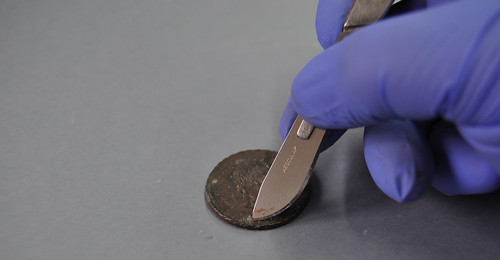
CASE STUDY
Here are photos of two small hoards of coins that spent more than 1,000 years in a pottery pot. Ideally, this would have been a dry environment with
air around some of the coins.
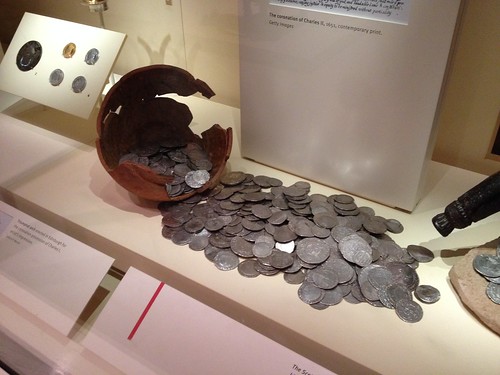
This pottery jug held a small hoard of silver coins in Scotland
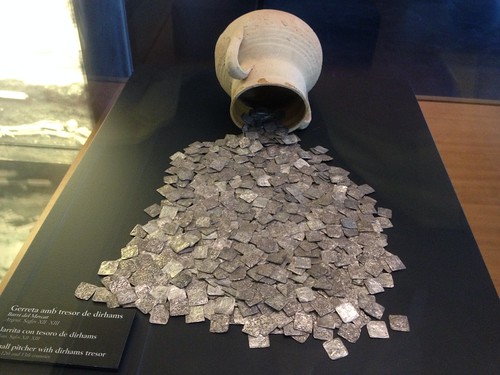
This pot held silver coins in Spain
CASE STUDY
These Roman silver coins minted at one of its German colonies were hidden away it such a way that the absolutely uncirculated nature of the pieces
were perfectly preserved. These no doubt were cleaned by museum specialists but you can see flawless beauty in the coins.
There are those who criticize some of the cleaning treatments archeologists do on coins. But in this case we see exactly how those coins looked just as they were struck for more than 1600 years ago. No harm done.

CASE STUDY
There is nothing worse to ruin silver coins than salt water. This shipwreck 8 reales piece really got chewed on over three centuries.

CASE STUDY
This gold cob was one of dozens that went down with a galleon off the coast of Florida and spent 300 years in salt water and sand. But thanks to the
nature of gold, that insult goes completely unseen. We could say that gold coins simply do not apply to this corrosion study.

A wild idea:
Someone could assemble a photo collection of example coins showing how various situations cause patina, tarnish and oxidation. (Tarnish being patina we don't like) This could include examples such as:
• Silver coin buried with others in a pottery pot for 500 years
• Silver coin buried with others in a copper pot for 500 years
• Copper coin buried with others in a pottery pot for 500 years
• Copper coin buried with others in a copper pot for 500 years
• Silver coin buried with others in a pottery pot for 100 years
• Silver coin buried with others in a copper pot for 100 years
• Copper coin buried with others in a pottery pot for 100 years
• Copper coin buried with others in a copper pot for 100 years
• Silver coin buried in dry dirt for 500 years (desert environment)
• Copper coin buried in dry dirt for 500 years in a cave
• Silver coin buried in occasionally moist dirt for 500 years
• Copper coin buried in occasionally moist dirt for 500 years
• Silver coin kept in a wood cabinet indoors for 100 years
• Copper coin kept a wood cabinet indoors for 100 years
• Silver coin kept in a wood cabinet indoors for 300 years
• Copper coin kept a wood cabinet indoors for 300 years
Well - you get the idea.
Has a study like this already been done somewhere? -Editor
To read the earlier E-Sylum articles, see:
UTAH SPANISH COIN FIND PUZZLES PARK SERVICE
(https://www.coinbooks.org/v22/esylum_v22n17a23.html)
Mystery of the Spanish
coins that predate Christopher Columbus by 200 years and have been found deep in the Utah desert

MORE ON MAGICIAN PROFESSOR KING
Last week Jud Petrie asked for more information about the enigmatic magician "Professor King". -Editor

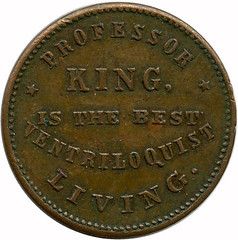
Jud Petrie adds:
I do have some information, but don't have the personal information on him, such as dates and places of birth and death. Bill Groom wrote an article on Professor King in the June 2017 NATCA 'Talkin Tokens'. King was probably a charlatan and fraudster. He was involved in a lawsuit over a scam in St. Albans Vermont where due to an error a prize went to someone other than the predetermined winner. I also have a newspaper article from February 1905 where Professor King, or someone using that name, performed a magic show in Homer, NY.
Ron Haller-Williams writes:
At http://www.magictoken.org/mtg.pdf you can find a catalog of magic tokens, of which 9 relate to ventriloquists (if you count all 3 versions of MT018).
See also (from over 7 years ago) http://ventdj.blogspot.com/2011/10/professor-king-token-1875.html and check out the pieces advertised at the right-hand side of http://maherstudios.blogspot.com/ plus the "hall of fame" ones at http://hofcoins.blogspot.com/
Julia Casey writes:
I wanted to forward a few notices I found from 1863 newspapers. I think based on the legends of the token being a near match to the wording used in the advertisements that this token can be dated to the Civil War token era.


Thanks, everyone. Julia also sent me the complete text of Bill Groom's article. -Editor
To read the earlier E-Sylum article, see:
NOTES FROM E-SYLUM READERS: MAY 12, 2019 : Information Sought on Magician Professor
King (https://www.coinbooks.org/v22/esylum_v22n19a10.html)
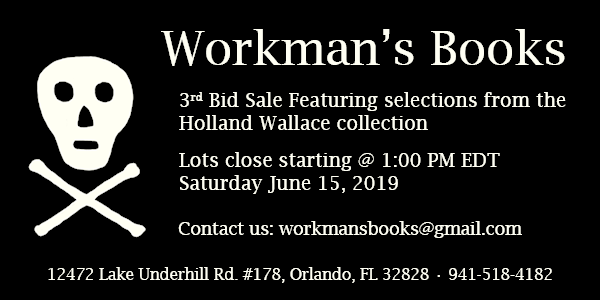
VOCABULARY TERM: CONVENTION BADGE
Dick Johnson submitted this entry from his Encyclopedia of Coin and Medal Terminology. Thanks. -Editor
Convention Badge. A medallic item, often of fraternal nature, bestowed upon delegates of a convention or meeting. Usually attached to ribbons and headers, convention badges were often designed with several components: bars, drops, pendants and such. All are intended to be worn, thus they have some method of fixing to a garment. Most convention badges were made by emblematic jewelry manufacturers but even the most traditional medal manufacturers produced these. The annual conclaves or encampments of the G.A.R. in the late 19th and early 20th century were the pinnacle of convention badge design for elaborateness (with many elements) and exotic components (even such components as sea shells, tree nuts, and lumps of coal!).
A later development was the lady's or auxiliary badge. Often of miniature size, approximately half size of the regular badge and ribbon, the ladies badge was designed to be more dainty, sometimes pierced, but always lighter in weight. For collectors, the American Numismatic Association carried convention badges even further in the mid 20th century. By omitting the loop and striking both the large regular and small lady's size in conventional (table) medals in several compositions, they created matched sets for numismatists. (Credit for this development was William T. Louth, president of Medallic Art Company, which then produced these for a number of years, and other medal makers followed suit.)
Looking for the meaning of a numismatic word, or the description of a term? Try the Newman Numismatic Portal's Numismatic Dictionary at: https://nnp.wustl.edu/library/dictionary
Or if you would like a printed copy of the complete Encyclopedia, it is available. There are 1,854 terms, on 678 pages, in The Encyclopedia of Coin and Medal Technology. Even running two a week would require more than 19 years to publish them all. If you would like an advance draft of this vital reference work it may be obtained from the author for your check of $50 sent postpaid. Dick Johnson, 139 Thompson Drive, Torrington, CT 06790.
ALONZO J. WHEELER (1805-1867)
Alonso J. Wheeler was a lifelong coin collector, machinist, inventor, manufacturer, and businessman for over forty years from the 1820's to the 1860's. He has remained in obscurity with only a four page letter that has survived that informs us about his coin collecting activities now in the Lupia Numismatic Library.
Alonzo J. Wheeler (1805-1867), was born on Saturday, January 12, 1805 at Albany, New York, the son of William Wheeler (1780-1851), and Martha Thorne (1776-1851).
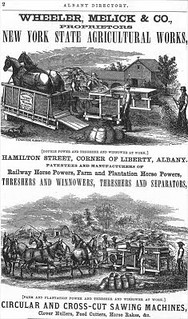

RIGHT: Wheeler, Melick & Co. trade card
In 1830, he was a co-partner with machinist, James H. Melick, in the firm of Wheeler, Melick & Co., Albany, New York, manufacturers of agricultural equipment. His thresher, winnowers, and separators were dominant in the farm machinery market.
He married Harriet Bishop (1813-1880), in 1834. They lived in Poughkeepsie, New York, with their four children : Seth Wheeler (1838-1925), Jane Wheeler (1840-), Ann Wheeler (1843-), Martha Thorne Wheeler (1853-).
His sister Mary Eliza Wheeler was born May 8, 1809 and died March 26, 1878. She married Solomon Crandell on December 20, 1832 at Chatham, Columbia, New York. Her son Homer was a coin collector like his uncle Alonso.

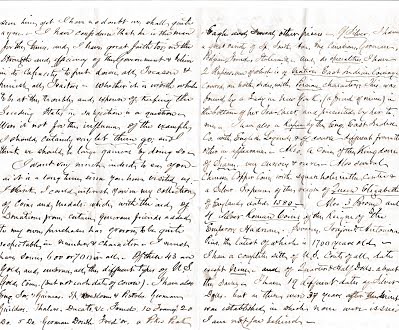
First three pages of Wheeler's 1861 letter
Wheeler wrote a four-page letter dated February 22, 1861 to his nephew Homer Crandell (1836-1912), telling him about his meeting the newly elected Abraham Lincoln at the train station, and rambles on about his coin collection with nearly all dates of Silver Dollars, Half Dollars & Quarters; 43 Gold Coins including all the different types! World Gold and Silver; Coins of the reign of Queen Elizabeth, and Ancient Roman coins. Ex-Kurt Krueger.
 He died of consumption at his residence 102 Grand Street, Poughkeepsie, New York, on Monday, January 21, 1867, and was interred three days
later in the Albany Rural Cemetery.
He died of consumption at his residence 102 Grand Street, Poughkeepsie, New York, on Monday, January 21, 1867, and was interred three days
later in the Albany Rural Cemetery.
Sounds like a nice collection. Are there any coins traceable back to Alonzo Wheeler? Where are they today?
Neither John nor I had heard of Wheeler before. Sometimes ephemeral material like this letter is the only remaining evidence of a collection. Thanks for publishing it! -Editor
To read the complete article, see:
WHEELER, ALONSO J.
(https://sites.google.com/a/numismaticmall.com/www/numismaticmall-com/wheeler-alonso-j)
The entire inventory of the Lupia Numismatic Library is for sale. Individual items will be available before the remaining archives are broken up into parcels sold at philatelic auctions in the U. S. and Hong Kong. Check NumismaticMall.com frequently as dozens of new items with estimates will be posted daily until everything is sold.
All inquiries will be given prompt and courteous attention. Write to: john@numismaticmall.com .

HARVEY STACK'S NUMISMATIC FAMILY, PART 44
Harvey Stack's blog series focuses on living in a numismatic family. Here is part 44. Thanks, Harvey. This installment is a tough one. -Editor
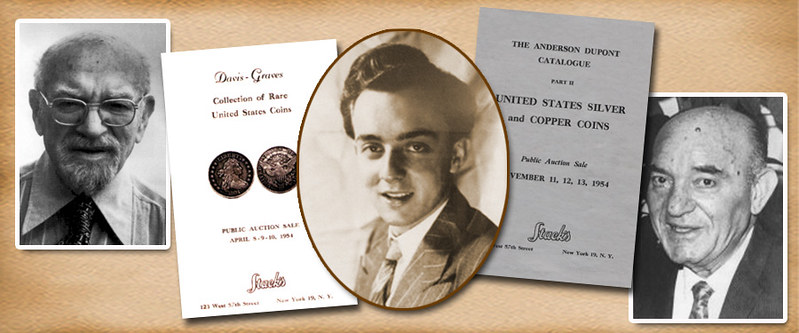
The year of 1966 was a challenging one for all of us at Stack's. There was a lot of work to do, serving clients, both in the shop and on the road, as well as holding auctions and traveling to conventions. In addition to this "usual" work, we were making our case about the OSGO's import standards and also preparing a specialized inventory for the estate of J.K. Lilly who had died. However, as 1966 ended, it became a year that I would always remember with pain and great sadness.
My father and uncle usually spent the winter, starting after Thanksgiving and for several months after in Florida, enjoying holidays with their families, and staying away from the cold in New York.
A few days before Christmas in 1966, my mother called and told me that my father, Morton Stack, was rushed to the hospital after having a severe heart attack. I immediately made plane reservations to go to Florida and started gathering a few things to take with me. Before I finished packing, my mother called again to tell me that my father had just passed away. She said I need not come to Florida, as she was planning to bring him back to New York for burial in a family plot. The news was such a shock to me, that I just sat down and cried. My father had been my teacher and mentor, and he set the example for how to treat people and build positive relationships with others. Now he was gone at the age of 66, and I knew I would miss him very much.
This tragedy was difficult for all of us at Stack's. We had lost a beloved member of our family and a very important part of our business. While losing a client of some 16 years like Josiah K. Lilly had been very hard for me and the others to take, this personal loss was much more painful. But it was necessary that we all continue on, despite the pain we were feeling. The work that we had all shared with my father went on, building the hobby and our own business and serving collectors as best we could. We also had our ongoing case against the government which, when and if we won, would benefit not only Stack's but also the entire numismatic community.
For me, my father's passing meant that I inherited another 25% of the business. In 1955 he had given me 25%, so now I was 50% owner of Stack's. My Uncle Joe still held 25%, while my cousins, Norman and Ben, each had the 12.5% that he as their father had given them. While we all worked together as always, I felt a great responsibility and weight upon my shoulders. It was good for me to concentrate on my work and on the many projects before us.
To read the complete article, see:
Harvey Stack Remembers: Growing up in a Numismatic Family, Part 44
(https://www.stacksbowers.com/News/Pages/Blogs.aspx?ArticleID=3376)
To read the earlier E-Sylum article, see:
HARVEY STACK'S NUMISMATIC FAMILY, PART 43
(https://www.coinbooks.org/v22/esylum_v22n18a17.html)

BOWERS ON COLLECTING: THE ANA AND THE ANS
On May 15, 2019 Dave Bowers published an article on Coin Update on the state of today's hobby and the ANA and ANS organizations. Here's an excerpt with some additional images provided by Dave. -Editor
Mike C. from Tennessee sent this:
The American Numismatic Society has existed long before the American Numismatic Association, yet the ANS clearly languishes in membership. I would like to hear any comments regarding this discrepancy in membership, as well as any differences between the workings of the two organizations.
In brief, both organizations are important to numismatics, but each is quite different from the other, and the two are not competitive. I have been a life member of the ANA and a fellow of the ANS since the 1950s.
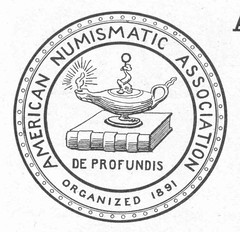 As you probably know, the ANA was founded by Dr. Geo. F. Heath in 1891. From the outset it aspired to be a "popular" organization, drawing
in casual collectors as well as experts. The Numismatist magazine, first published by Heath in 1888, was in time acquired by the ANA and today
is published monthly. Under Editor Barbara Gregory it is one of the most diverse, most interesting publications in all of numismatics.
As you probably know, the ANA was founded by Dr. Geo. F. Heath in 1891. From the outset it aspired to be a "popular" organization, drawing
in casual collectors as well as experts. The Numismatist magazine, first published by Heath in 1888, was in time acquired by the ANA and today
is published monthly. Under Editor Barbara Gregory it is one of the most diverse, most interesting publications in all of numismatics.
The ANA holds its World's Fair of Money annual convention each summer, often drawing close to 10,000 registrants, sometimes higher. The peak seems to have been attained in 2000 with the Ship of Gold exhibit being an important drawing card. In Colorado Springs the Headquarters building includes a museum, the ANA Hall of Fame, and offices for the staff. Visitors are warmly welcomed. The Young Numismatists program encourages the younger set to become interested in numismatics. The Summer Seminar offers classes on various subjects.

ANA Colorado Springs headquarters
In summary, the ANA is more popular than academic.
 In contrast, the ANS is more academic than popular. It does not have a division for young numismatists, it does not hold conventions in
cities around the country, it does not issue a monthly magazine with news, schedules, popular columnists, and more.
In contrast, the ANS is more academic than popular. It does not have a division for young numismatists, it does not hold conventions in
cities around the country, it does not issue a monthly magazine with news, schedules, popular columnists, and more.
Founded by Augustus B. Sage in New York City in March 1858, the ANS was dynamic that year and in 1859, after which it disappeared. Why this was so I have never been able to find out, despite a lot of historical research and even writing a book with much information about the ANS. In 1864, a new and unrelated organization arose in New York City, the American Numismatic and Archeological Society, with nearly all different people. The "Archeological" word was added to draw in more members. In practice, the society never did much other than numismatics, and the word was later dropped, to create the new American Numismatic Society.
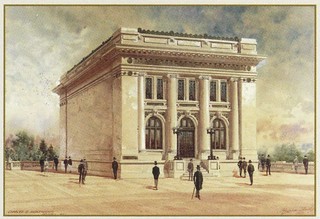 In May 1866, the American Journal of Numismatics made its debut as a monthly, later issued less frequently. It contained research
information, news of new issues, numismatic articles treating eras from ancient times down to the present, reviews of auctions with prices, and more.
In 1908, a magnificent temple-like building for the ANS was opened on Audubon Terrace in the Morningside Heights area of upper Manhattan - then a
center for society. The benefactor was Archer Huntington, a railroad fortune heir. Around the architrave were names of famous numismatists. Only one
was an American, CROSBY. In the late 1920s, Huntington donated most of the funds for the sister building next to and attached to the first.
In May 1866, the American Journal of Numismatics made its debut as a monthly, later issued less frequently. It contained research
information, news of new issues, numismatic articles treating eras from ancient times down to the present, reviews of auctions with prices, and more.
In 1908, a magnificent temple-like building for the ANS was opened on Audubon Terrace in the Morningside Heights area of upper Manhattan - then a
center for society. The benefactor was Archer Huntington, a railroad fortune heir. Around the architrave were names of famous numismatists. Only one
was an American, CROSBY. In the late 1920s, Huntington donated most of the funds for the sister building next to and attached to the first.
For most of the 20th century, continuing into the present, the main emphasis has been on ancient coins, including books and tours to ancient sites. United States coins have not been neglected. Far from it. Some years ago the Coinage of the Americas Conference (COAC) was held each year. Today, events and books relating to American numismatic are more occasional than frequent. I hasten to mention the semi-annual Journal of Early American Numismatics (JEAN) under the editorship of Christopher McDowell assisted by editorial staff.
 Once each year the ANS has its Gala dinner in New York City, to honor numismatists and to raise funds. Several hundred people typically
attend. I was the honoree in 2006. On Varick Street, the ANS headquarters is on a floor of the refurbished former Herald Tribune printing
plant. Furnished in fine style, it has a gallery and reception area open to the public. It also has the greatest numismatic library in the world,
including the finest in American subjects. This is open to scholars by appointment.
Once each year the ANS has its Gala dinner in New York City, to honor numismatists and to raise funds. Several hundred people typically
attend. I was the honoree in 2006. On Varick Street, the ANS headquarters is on a floor of the refurbished former Herald Tribune printing
plant. Furnished in fine style, it has a gallery and reception area open to the public. It also has the greatest numismatic library in the world,
including the finest in American subjects. This is open to scholars by appointment.
Ideally, I recommend that readers join both groups. They complement each other and have different assets and programs. In terms of numismatic budgets, the cost is pocket change.
Here is what to do: Check the website of each. Give it a try. I guarantee you will enjoy numismatics more than ever!
I, too belong to both ANA and ANS, so I agree with Dave's advice. ANS does issue ANS Magazine, which includes some wonderful articles, photography and Society news. -Editor
To visit the American Numsimatic Association web site, see:
https://www.money.org/
To visit the American Numsimatic Society web site, see:
http://numismatics.org/
To read the complete article, see:
Bowers on collecting: The ANA and the ANS
(http://news.coinupdate.com/bowers-on-collecting-the-ana-and-the-ans/)
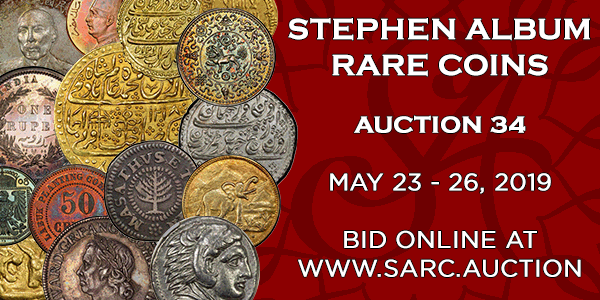
SOME INTERESTING MEDALS: MAY 19, 2019
Here are a few medals that caught my eye in Joe Levine's Presidential Coin & Antique Co., Inc. Mini Fixed Price List of Tokens and Medals #153. Thanks for Joe for sending the images and text. -Editor
1864 CATHEDRAL OF ST. PETER AND ST. PAUL MEDAL

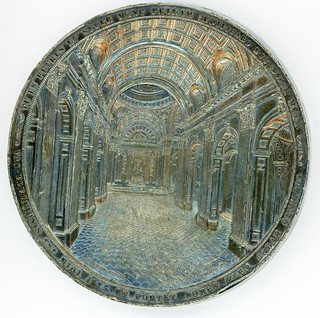
PHILADELPHIA CATHEDRAL OF ST. PETER AND ST. PAUL DEDICATION MEDAL, 1864. Eidlitz 1129. 80mm. Silvered White Metal. Anthony Paquet , Sc. AU with lightly hairlined reflective surfaces.
The obverse bears a view of the front of the cathedral. Above: CATHEDRAL OF ST. PETER AND ST. PAUL, PHILADELPHIA. In exergue: BEGUN 1846/ COMPLETED 1864. The reverse legend is inscribed on a narrow band around a three dimensional view of the interior of the cathedral: TU ES PETRUS ET SUPER HANC PATRAM AEDIFICABO ECCLESIAM MEAM. VAS ELECTIONIS EST MIHI ISTE UT PORTET NOMEN MEUMCORAM GENTIBUS.
This medal was originally issued for the completion of the cathedral in 1864. Apparently, a number of them were left over and when the cathedral was consecrated in 1890, the unused pieces were engraved with the consecration date. The New York Times called this medal, "The handsomest ever issued in the United States and the most artistic and elaborate design ever cut by (Paquet)." The superb three dimension reverse style was first popularized by the Austrian medallist, Jacques Wiener. $1,600.00
Great medal for a great building. -Editor
1901 PAN AMERICAN EXPOSITION OFFICIAL AWARD MEDAL
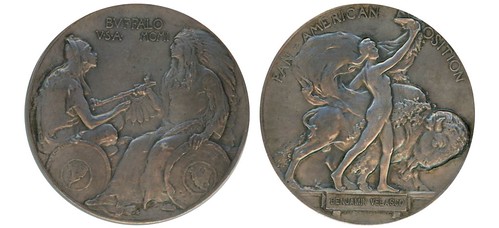
PAN AMERICAN EXPOSITION OFFICIAL AWARD MEDAL, 1901. Baxter 106; Marqusee 250. 63.7mm. Edge marked with the Gorham hallmark And STERLING About Uncirculated.
The obverse, a bonneted Indian on the right rests his hand on a shield bearing a map of North America. He shares a peace pipe with a Mayan Indian, against whom rests a shield with the map of South America. The reverse bears a nude female figure of Liberty wearing a Phrygian hat to the right. The famous buffalo, Black Diamond, wearing a garland, is butting beside her. On a cartouche below the figure of Liberty is the struck is inscribed the name of the awardee, BENJAMIN VELASCO, Vermule traces the spiritual genesis of James Earl Fraser's design for the buffalo nickel to MacNeil, and in particular, to this work. $1,750.00
Another beautiful medal. -Editor
1904 FINE ARTS FEDERATION OF NEW YORK PLAQUETTE

RARE NAMED FINE ARTS FEDERATION OF NEW YORK PLAQUETTE, ( 1904) Smedley 61. 105.8 x 77.6mm. Bronze. Victor D. Brenner, Sc. XF/AU with scattered minor field marks.
A classically dressed female figure (Art) walks to the left holding painting implements in the left hand a small statue of Winged Victory in our outstretched right hand. Inscribed across the center is: FINE ARTS/ FEDERATION/ OF NEW YORK. This is the official seal of the organization. Reverse: Inc used inscription: MEDAL OF HONOR/ PRESENTED TO/ FRED PAPERT/ MODEL CITIZEN/ AND. CHAMPION OF DEVELOPMENT/ IN THE/ PUBLIC INTEREST/ NOVEMBER 17, 2009.
Founded in 1895, the Fine Arts Federation is the only alliance of its kind acting on behalf of New York City's art and design professions to advocate for design excellence in the five boroughs and beyond. Among other accomplishments, Fred Papert helped rally support to save Grand Central Station from being demolished and helped transform Times Square from an unsafe and seedy symbol of urban decay into what Mr. Papert foresaw as a "cultural amusement park."
Rare - Smedley was unable to find a medal to picture for his catalogue. In our 2014 Sale #84, we sold an unawarded relatively modern restrike for $460.00. $550.00
Important medal, important recipient. -Editor

WAYNE'S NUMISMATIC DIARY: MAY 19, 2019
Tuesday May 12, 2019 was the meeting night of my Northern Virginia numismatic social group Nummis Nova. Aaron Packard was our host, and the venue was Southside 815 at 815 S. Washington St in Alexandria, VA. It's a classic bar and restaurant with great food - we've been there three or four times now.
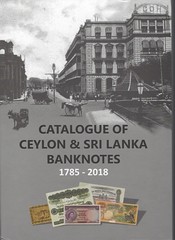 I arrived about 6pm and already seated were Gene Brandenberg, Dave Schenkman and Eric Schena. Soon Aaron, Steve Bishop, Mike Packard (no
relation to Aaron), Julian Leidman and his guest Scott Spitzer arrived.
I arrived about 6pm and already seated were Gene Brandenberg, Dave Schenkman and Eric Schena. Soon Aaron, Steve Bishop, Mike Packard (no
relation to Aaron), Julian Leidman and his guest Scott Spitzer arrived.
My only numismatic exhibit was a new book on the banknotes of Ceylon & Sri Lanka, sent to me by my old friend Kavan Ratnatunga. It had only take five days to ship from Sri Lanka! Stay tuned for ordering information once the book is more broadly available.
Old-Time Postage Stamps
I'd been to the post office earlier in the week and picked up some postage stamps for the few dues payments and cards I still sent the
old-fashioned way. Several are memberships to coin clubs that don't have an easy way to pay online.
Anyway, I brought my purchases along to the meeting and people were impressed with the products, as was I. The Classics Forever series reproduce famous early U.S. postage stamp designs. The second sheet is a set of stamps commemorating the 150th anniversary of the completion of the Transcontinental Railroad. Both are impressive physical products that can't be reproduced in an email.


Schenkman's Scrip
Dave Schenkman passed around a couple of interesting scrip notes from last month's Heritage sale.
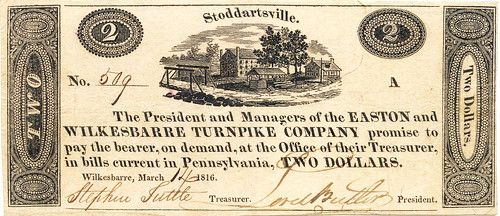
Easton & Wilkesbarre Turnpike Co. Two Dollar Note

Dave's a big collector of Turnpike notes. I appreciate them for their connection to the development of transportation infrastructure in this country. But the second note was especially interesting. It will take some research, but we both believe it may be connected to the operations of pioneer gold coiner Christian Bechtler of Rutherford, North Carolina. Here's a Rutherford Gold Company Stock Certificate from a 2017 Kagin's sale:
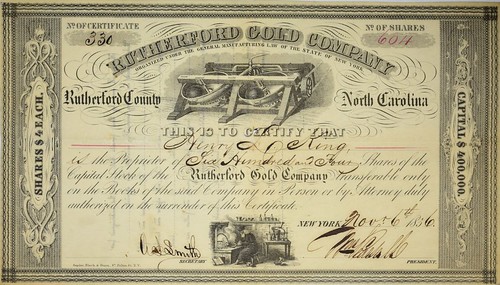
To read the complete lot description, see:
Rutherford Gold Company Stock Certificate
(https://auctions.kagins.com/Rutherford-Gold-Company-Stock-Certificate_i26659812)
Eric's Finds
Eric Schena had some interesting recent finds. I'll let him describe them.
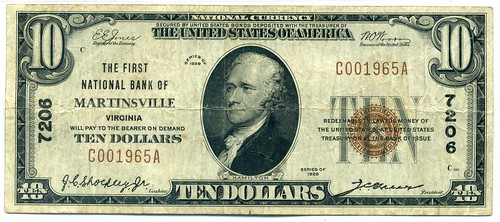
"I brought a couple of great items that my wife found at a recent local auction in Collinsville, VA. First is a $10 small size national from the First National Bank of Martinsville, a scarcer bank from the state. It's neat to think that note spent most of the past 90 years in the same county."
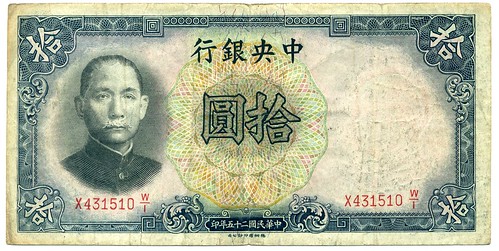

"The second item came in a lot of mixed foreign currency and coins that she snagged for $25. The lot had a bunch of silver coins, the bullion value alone was more than $25, plus a number of interesting foreign notes. The most intriguing is this 1936 10 Yuan note from the Central Bank of China. At first glance, it's a very common note worth maybe a few bucks and not really worth much attention. However, the note is missing the red signature seals from the obverse and the English signatures from the reverse.
In doing some digging, this appears to have been a remainder that somehow found its way into circulation - the online reference I found indicated that there are several types of scarce remainders all made by Thomas De La Rue that somehow found their way into circulation. It's unlisted in Smith-Matravers and Pick and I could find only one obscure sale record from more than a decade ago. If any experts on Chinese paper are out there, please chime in if they know more about these TDLR remainders. She certainly has an eye for finding neat items."
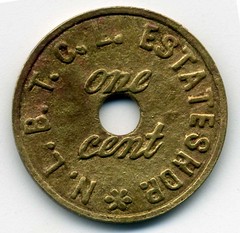

"I also brought along an unusual though not especially rare token as a "what is it?" quiz item. It's a tobacco plantation token from the New London Borneo Tobacco Company, Ltd. Estate Shop. Located in British North Borneo (now the state of Sabah in Malaysia), these tokens were used around 1906 to 1910 and were used to pay the principally Chinese laborers at the company's plantations - the Chinese characters on the reverse translates to "one cent in exchange."
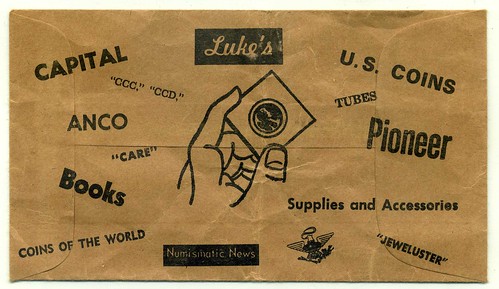

"Gene gave me a very interesting relic from Northern Virginia's coin dealer past: an envelope from the West End Dealer Exchange in Falls Church. No one at the table could immediately identify who the dealer was, though. If anyone knows who the dealer/owner was, we'd all love to hear it."
Roosevelt plaque
Steve Bishop brought this small Theodore Roosevelt plaque by Tournier.
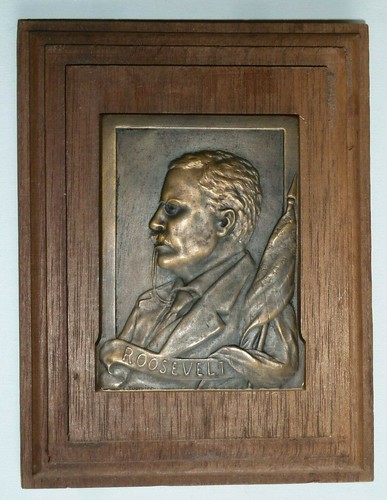
Interesting stuff - some neat finds. It was a fun meeting, as always.

RARE COIN OF ULPIUS CORNELIUS LAELIANUS FOUND
Dick Hanscom and David R Pickup forwarded this BBC News article on a new coin find. Thanks! -Editor
David writes:
Ulpius Cornelius Laelianus (also incorrectly referred to as Lollianus and Aelianus) was a usurper against Postumus, the emperor of the Gallic Empire. His revolt lasted from approximately late February to early June 269.

An "incredibly rare" Roman coin minted for an ill-fated emperor has been found during work to upgrade an A road.
It depicts Ulpius Cornelius Laelianus, who reigned for about two months in AD269 before he was killed.
Archaeologist Steve Sherlock said the "significant' find was only the second of its kind to be unearthed in England.
The coin shows Laelianus wearing a radiant crown and was found in a ditch at a small Roman farmstead by archaeologists.
Coin expert Julian Bowsher, of MOLA Headland Infrastructure, said: "Roman emperors were very keen to mint coins - Laelianus reigned for just two months which is barely enough time to do so.
"The fact that one of these coins ever reached the shores of Britain demonstrates remarkable efficiency and there's every chance that Laelianus had been killed by the time this coin arrived in Cambridgeshire."

Another unusual coin discovered during the dig was a Gallic War Uniface coin, minted in 57BC by the Ambiani tribe in the Somme area of modern-day France.
Experts believe it was exported to help fund the British Celtic resistance to Julius Caesar.
To read the complete article, see:
'Incredibly rare' Roman coin found during A14 roadworks
(https://www.bbc.com/news/uk-england-cambridgeshire-48314102)

ALTERED DATE "1880" SHIELD NICKEL
It's been a while since we discussed a counterfeit coin. Here's an article from NGC about an altered date "1880" Shield Nickel. -Editor
In 1880, the US Mint struck 3,955 Proof and 16,000 Mint State Shield Nickels. Interestingly, those numbers represent the second-highest mintage of the series for Proof coins, and the lowest mintage of the series for circulation issue pieces.
Although they had a higher mintage, the Mint State coins fetch a far bigger premium in today's marketplace. For example, just this January an NGC AU 55 example sold for nearly $4,000 while an NGC PF 66★ brought only $1,020 in the same auction.
Due to the extremely large price difference between the Mint State and Proof coins, as well as between this date and other dates, NGC graders must remain extremely vigilant in looking for counterfeits and alterations.
Recently, a Mint State example of this rare coin was submitted by a collector for certification.
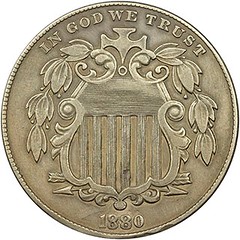
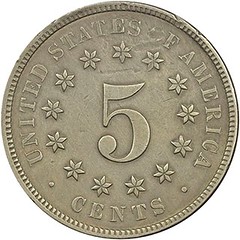
Unfortunately for the submitter, the coin they sent in was not a genuine 1880 Shield Nickel.
At first glance, the coin already looks concerning. The surfaces have clearly been altered as they have an odd matte-like appearance with no luster. That alone would immediately raise the suspicions of the grader that perhaps this is a Proof altered to appear Mint State.
However, that is not the case. Instead, take a closer look at the date.
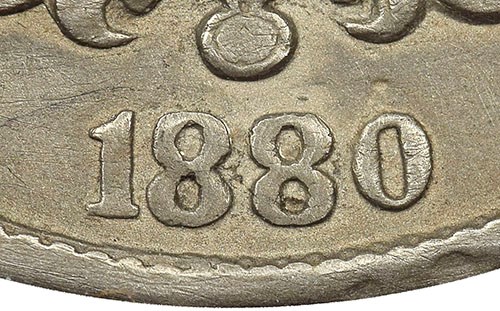
As you can see, the "0" in the date looks much smaller and has a different surface texture than the other three digits. This is due to the fact that the digit was likely formed by a forger using the metal that was there from a previous digit. Looking at the mintage figures, it seems very likely that the coin was originally dated 1882 or 1883 as those coins had mintages of 11.4 million and 1.4 million, respectively.
Clearly, this would be a profitable endeavor for a counterfeiter, as the Guide Book of United States Coins (the Red Book) lists the G-4 values of the 1882 and 1883 issues at $25, whereas the 1880 in the same grade is $1,500!
It is possible that the counterfeiter had to alter the entire surfaces of this coin to make his efforts to change the date less obvious. Still, this coin was not a particularly well-done alteration. It was clearly deceptive enough, however, to slip by at least one collector. This is why it is important to always closely inspect the date or mintmark on rare dates or date-and-mintmark combinations.
To read the complete article, see:
Counterfeit Detection: 1880 Shield Nickel
(https://www.ngccoin.com/news/article/7403/counterfeit-detection-may-2019/)
THE BOOK BAZARRE
U.S. MINT SUSPENDS MUTILATED COIN PROGRAM
The U.S. Mint has again halted its mutilated coin redemption program. This Recycling Today article was found via the May 14, 2019 issue of News & Notes from the Society of Paper Money Collectors. -Editor
 The U.S. Mint, Washington, suspended its mutilated coin redemption program this May. The U.S. Mint receives large bundles of coins that
have been mutilated or damaged in the recycling process of used cars, vending machines, laundry machines and other sources. The program has been
operated by U.S. Mint for many decades.
The U.S. Mint, Washington, suspended its mutilated coin redemption program this May. The U.S. Mint receives large bundles of coins that
have been mutilated or damaged in the recycling process of used cars, vending machines, laundry machines and other sources. The program has been
operated by U.S. Mint for many decades.
Several years ago, the U.S. Mint suspended this program while pursuing litigation. Scrap recyclers had to store these recovered unusable coins during that period. The U.S. Mint had previously resumed operation of the mutilated coin redemption program in January 2018 as it released new guidelines and certifications for submissions.
Some of the new guidelines include the establishment of procedures for certifying participants based on submission amounts and frequency, sampling submissions to authenticate material, conducting site visits for certain participants and requiring information about how the submissions came to be bent or partial. The Institute of Scrap Recycling Industries (ISRI), Washington, reports that this was considered a major victory for the recycling industry, which had been stockpiling mutilated coins during the moratorium.
As recycling technology has advanced the ability to accumulate coins in significant quantities has grown quickly, ISRI reports that this is an integral part of many recycling companies' operations and product lines. According to an ISRI news release, the association is reaching out to the U.S. Mint to determine why the program was suspended. ISRI hopes to see the program resume operations as soon as possible.
To read the complete article, see:
US Mint suspends mutilated coin redemption
program (https://www.recyclingtoday.com/article/us-mint-suspends-mutilated-coin-redemption-program-again/)

Coin World image composed from U.S. Mint photos
To read Coin World's coverage, see: https://www.coinworld.com/news/us-coins/2019/05/us-mint-suspends-mutilated-coin-redemption-program.html
To read earlier E-Sylum articles, see:
RECYCLERS DEFRAUD U.S. MINT WITH CHINESE COUNTERFEIT COINS
(https://www.coinbooks.org/esylum_v18n13a13.html)
CHINESE COIN RECYCLER HOLDS OPEN HOUSE
(https://www.coinbooks.org/esylum_v19n15a24.html)
WSJ EXAMINES DAMAGED AND SCRAP COIN RESALE PROGRAM
(https://www.coinbooks.org/esylum_v19n19a23.html)
U.S. MINT RESUMES MUTILATED COIN PROGRAM
(https://www.coinbooks.org/v21/esylum_v21n05a32.html)
BETTING ON NICKELS
Economist JP Koning recently blogged about speculation in the value of a hoard of U.S. five-cent coins, the lowly nickel. Here's an excerpt. -Editor
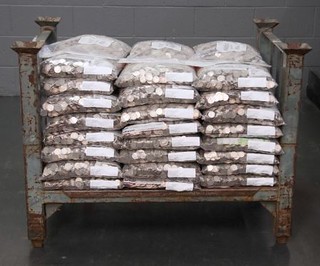 In 2011, hedge fund manager Kyle Bass reportedly bought $1 million worth of nickels. Why on earth would anyone want to own 20 million
nickels? Let's work out the underlying logic of this trade.
In 2011, hedge fund manager Kyle Bass reportedly bought $1 million worth of nickels. Why on earth would anyone want to own 20 million
nickels? Let's work out the underlying logic of this trade.
A nickel weighs five grams, 75% of which is copper and the rest is nickel. At the time that Bass bought his nickels, the actual metal content of each coin was worth around 6.8 cents. So Bass was buying 6.8 cents for 5 cents, or $1.36 million worth of base metals for just $1 million.
To realize this 6.8 cents, Bass would have to sell the copper and nickel as metal, not coin. But liberating the actual metal from each token isn't so easy. Since 2006 it's been illegal to melt pennies and nickels down. As a regulated hedge fund manager, Bass probably isn't willing to break the law. Which means he'd only be able to realize the metal content of nickels indirectly, by on-selling them to a buyer who is willing take on the risks of melting nickels. That wouldn't be me, mind you. Five years in jail sounds like a long time.
At the right price, would-be smelterers will surely emerge out of the woodwork to buy Bass's stash. Say the prices of nickel and copper explode such that a nickel now contains 20 cents worth of metal. Bass should have no problems finding someone who'd pay him 12-15 cents for each of his nickels. Bass wouldn't be doing anything illegal, he'd just be selling nickels on to a stranger at a premium. And given that he only paid face value for each nickel, he'd be more than doubling his bet.
So Bass has upside exposure to the next bull market in copper and nickel prices. The neat part of this trade is that he has no downside exposure. That's because a nickel can never be worth less than its face value of five cents.
Of course, hauling, storing and shipping all those nickels takes time and money, too, and Koning goes on to investigate that. Interesting reading. Check out the complete article at the link below. -Editor
To read the complete article, see:
Kyle Bass's big nickel bet
(https://jpkoning.blogspot.com/2019/05/kyle-basss-big-nickel-bet.html)
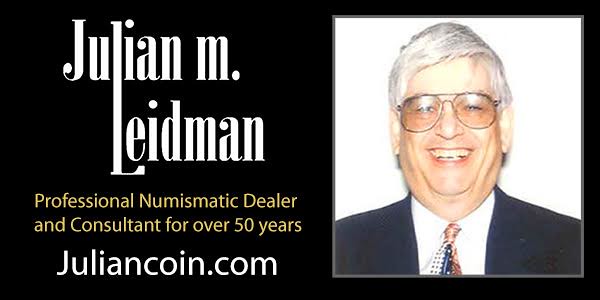
VIETNAM TO SELL UNPOPULAR COINS AS SCRAP METAL
On the topic of recycling coins, here's an article forwarded by Pabitra Saha on Vietnam's plan to simply scrap over 600 tons of unwanted, unneeded coins. -Editor
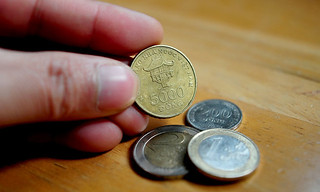 Vietnam will auction over 600 tons of coins, whose minting has been stopped for years now because of their lack of popularity.
Vietnam will auction over 600 tons of coins, whose minting has been stopped for years now because of their lack of popularity.
The State Bank of Vietnam (SBV) said it would auction the coins after turning them into metal scrap with a reserve price of VND48 billion ($2 million).
Vietnam began minting coins in 2003 to facilitate payment on buses and vending machines.
But they were met with public apathy because they were hard to use due to their small size and vending machines are rarely seen in the country.
The SBV stopped the production in 2011.
To read the complete article, see:
Vietnam to auction unused coin
currency as scrap (https://e.vnexpress.net/news/business/economy/vietnam-to-auction-unused-coin-currency-as-scrap-3923225.html)

2019 HORNBY ISLAND MUNICIPAL TRADE TOKENS
Last year Jim Bulmer created a fundraising local currency on Hornby Island in British Columbia, Canada. Here's an update with information on the 2019 edition. Thanks. These are a fun and useful way to raise funds for good local causes. Readers looking for more information, or to acquire examples can contact Jim at jbulmer57@hotmail.com. -Editor
NEW HORNBY TRADE TOKEN CELEBRATES FIRST NATIONS TOTEM POLE

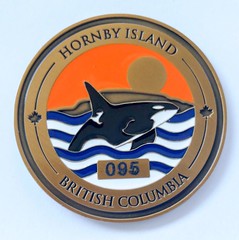
The Hornby Island Trade Token is in its second year. It is a Municipal Trade Token with a face value of $20.00, and will be valid in trade on Hornby Island, British Columbia with participating merchants and artisans until it expires, October 31, 2019. An accompanying 1 1/4" Pin of the Island and Orca side ($3.00) will also be available. Mintage: Tokens: 500; Pins: 800.
Conservation is the watchword of the Island and the Obverse of this year's Hornby Trade Token depicts a the Island with an Orca swimming in front, to represent the importance of our resident Orca population. The Reverse features Hornby Island's new K'omoks First Nation Totem Pole, carved by artist Karver Everson, which depicts Thunderbird and Sisiutl, lords of the Upper and Lower Worlds, and a Herring beneath signifying the yearly Herring Spawn which vitalizes our sea life: Orcas, Sea Lions, Salmon and countless other varieties of Fish and Sea Birds.
The Pole was erected on Hornby Island last August in Helliwell Provincial Park as a token of friendship and momento of the "unceded land of the Pentlatch People" on which our small population resides. The Token Project received the generous permission of the artist to use the totem pole image on this years' issue.
It is a Fundraising Token. Like a $20 Gift Card, it is fully backed by money in the bank, so can be used with no loss to the merchant. All profits from this project go to the Hornby Island Community Fund, and the visitors and collectors who take them home help support the entire island.
Last year, the first, the Token Project donated $1,000 to the School Fund (our school burned down last August), and $1,000 to the Community Fund. This year's token should be a sellout.
To read the earlier E-Sylum article, see:
HORNBY ISLAND MUNICIPAL TRADE TOKENS
(https://www.coinbooks.org/v21/esylum_v21n30a27.html)

CARSON CITY COIN PRESS STRIKES RAILROAD MEDAL
Good ol' Coin Press No. 1 keeps on keepin' on. This article from Carson City, NV published on Monday detailed plans for yesterday's striking of a medal commemorating the completion of the nation's first transcontinental railroad. -Editor
 Carson City's two state museums - the Nevada State Museum and Nevada State Railroad Museum - are collaborating on a project that highlights
of 150-year-old artifacts in both museums' collections.
Carson City's two state museums - the Nevada State Museum and Nevada State Railroad Museum - are collaborating on a project that highlights
of 150-year-old artifacts in both museums' collections.
This Saturday, May 18, the Nevada State Museum will fire up its 150-year-old Coin Press No. 1 for the first public minting of a medallion that commemorates the Nevada State Railroad Museum's Coach 17 - the only rail car still in existence that was present at the completion of the nation's first transcontinental railroad at Promontory Summit in Utah.
The medallion minting, which starts at noon, is another in a series of "Mint150" programs taking place at the Nevada State Museum as it celebrates the 150th anniversary of the U.S. Branch Mint in Carson City. Coin Press No. 1 was the first coin press in the Carson City Mint and it produced millions in gold and silver coins in its heyday.
The 30 mm, .999 fine silver medallion features an image of Coach 17 with the words "Promontory Car, Transcontinental Railroad, 1869-2019" and an image of a railroad spike. The event at Promontory in 1869 featured the ceremonial driving of golden and silver spikes to mark the joining of the Central and Union Pacific railroad lines.
Museum visitors can purchase a pure silver blank in the museum store for $60 and have it minted as they watch.
The day's program also includes a special tour of the Mint Building, where participants can learn where various mint functions actually took place, including a behind-the-scenes look at a few of the building's nooks and crannies usually off limits to the public. A pair of hour-long tours are planned, one at 10 a.m. and another at 1:30 p.m.
To read the complete article, see:
Carson City museums to
mint medallion to memorialize Transcontinental Railroad car
(https://carsonnow.org/story/05/13/2019/carson-city-museums-mint-medallion-memorialize-transcontinental-railroad-car)

CYRUS-TRUMP PROCLAMATION COIN PROMOTED
The Hill blog discussed a medal picturing President Trump being sold on TV for $45. Political candidates and their supporters produce a wide range of numismatic items ranging from campaign buttons and tokens to inaugural medals. It will be interesting to see how the numismatica of today's era gets cataloged by writers of the future. -Editor
 "The Jim Bakker Show" recently promoted a coin decorated with President Trump's face as a "point of contact" with
God.
"The Jim Bakker Show" recently promoted a coin decorated with President Trump's face as a "point of contact" with
God.
In a viral clip of the promotion, evangelical author Lance Wallnau described the $45 coin as a means for believers to establish a "point of contact" with God.
"When I asked the Lord 'Why the coin?' he said 'Because when you take the coin, it's a point of contact,'" Wallnau said in the clip, which was shared on Twitter by Right Wing Watch, which "monitors and exposes the activities of Radical Right political organizations."
The coin depicts a photo of Trump alongside King Cyrus, the founder of the first Persian empire, and includes text reading "The 70 Year Decree" and "Cyrus-Trump Proclamation."
Last year, Wallnau referred to Trump as "modern-day Cyrus," saying at the time that "America's going to have a challenge either way. With Trump, I believe we have a Cyrus to navigate through the storm," according to Vox.
To read the complete article, see:
Televangelist's show
sells $45 Trump coin as 'point of contact' to God
(https://thehill.com/blogs/blog-briefing-room/news/443997-televangelist-sells-45-trump-coin-being-peddled-to-believers-as)
For an opinion piece, see:
Why a $45 Trump prayer coin is no
joke (https://religionnews.com/2019/05/17/why-a-45-trump-prayer-coin-is-no-joke-lance-wallnau-jim-bakker/)
MORE ON WEST VIRGINIA'S UNCLAIMED MEDALS
Paul Horner forwarded this article with some additional information and images on the unclaimed Tiffany-made West Virginia Civil War medals discussed last month. Thanks. -Editor
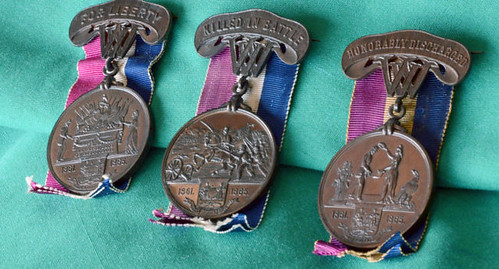
An act of the West Virginia legislature 152 years ago is still active and in the process of being carried out. Lawmakers in 1866 authorized creation of a medal to be given to all West Virginia soldiers who fought in the Civil War.
The medals were meant to be a token of appreciation from a grateful state. But handing them out proved to be a challenge.
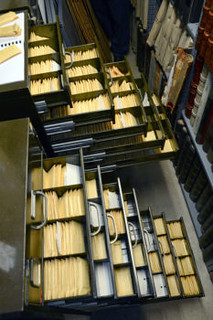 Initially the state gave out about 19,000 medals in 1866, but over subsequent years the numbers declined. In 1890, the Grand Army of the
Republic became involved and manged to give away several thousand more over the course of 10 years. In 1907, the medals were turned over to the State
Archives to continue the distribution.
Initially the state gave out about 19,000 medals in 1866, but over subsequent years the numbers declined. In 1890, the Grand Army of the
Republic became involved and manged to give away several thousand more over the course of 10 years. In 1907, the medals were turned over to the State
Archives to continue the distribution.
A total of 3,392 medals remain at the Capitol to be awarded. They are neatly tucked away in individual envelopes in a storage cabinet deep inside the State Archives. There are three different categories of medals. Most of the medals were Honorable Discharge Medals, which included the greatest number of West Virginia soldiers. There is also a category for Killed in Battle and a third category called For Liberty which included soldiers who died of disease, wounds, or other causes during their active military service.
"The medals have different scenes on the face," Marcum said. "The really nice part is they have the veterans name and unit engraved on the edge of the medal."
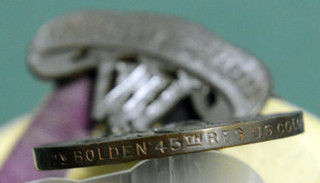 "Some of these soldiers were from Pennsylvania and some were from Ohio," said Marcum. "Union regiments in those states filled up rather
quickly, then when West Virginia started filling up their regiments, those guys who couldn't get into their own state came over and joined West
Virginia's regiments."
"Some of these soldiers were from Pennsylvania and some were from Ohio," said Marcum. "Union regiments in those states filled up rather
quickly, then when West Virginia started filling up their regiments, those guys who couldn't get into their own state came over and joined West
Virginia's regiments."
Any descendant who wants to start the process of obtaining a medal of a departed relative can begin at the website off the West Virginia Culture and History website.
To read the complete article, see:
More than 3,000 W.Va. Civil War medals
waiting to be awarded (http://wvmetronews.com/2019/04/25/more-than-3000-w-va-civil-war-medals-waiting-to-be-awarded/)
To read the earlier E-Sylum article, see:
WEST VIRGINIA'S UNCLAIMED CIVIL WAR MEDALS
(https://www.coinbooks.org/v22/esylum_v22n15a28.html)

TURKEY'S GÖBEKLITEPE COMMEMORATIVE ZERO EURO
Numismatists in Turkey have produced a commemorative "zero euro" promotional banknote. This article was found via the May 14, 2019 issue of News & Notes from the Society of Paper Money Collectors. -Editor
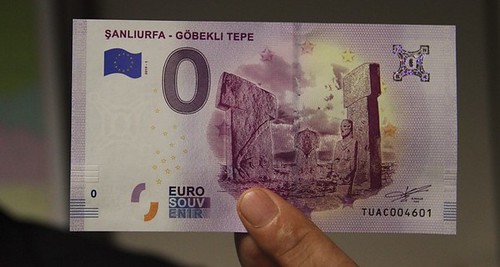
Göbeklitepe, one of the oldest sites of archaeological ruins and one of the oldest temples in the world, located in Turkey's southeastern Şanlıurfa province, is featured on new euro bills printed for commemorative purposes and used for tourism.
Considered the birthplace of human civilizations, Göbeklitepe will define Turkish tourism policy this year. To promote one of the most important and ancient archaeological sites, the government has declared 2019 as the "Year of Göbeklitepe."
Thus, numismatist Özgür Honça and his teammates İbrahim Gölgeli and Christian Petermann, printed commemorative euro bills in real euro standards at the institution that is licensed by the European Central Bank (ECB) to issue money for tourism purposes. The commemorative euro bill features the picture of Göbeklitepe; however, there is also a "0" to avoid its use for trade transactions.
Honça said that they initiated these efforts to promote Göbeklitepe in a more effective way, adding, "The bill has been issued by a private institution authorized and licensed by the ECB solely for commemorative and tourism purposes."
To read the complete article, see:
New euro banknote features Göbeklitepe
(https://www.dailysabah.com/business/2019/05/13/new-euro-banknote-features-gobeklitepe)

FT HIGHLIGHTS BULGARI COIN JEWELLERY
Jewellery made from or incorporating coins goes back to ancient times. In a May 17, 2019 article, the Financial Times profiles the Bulgari family of Rome and their famous line of coin jewellery. -Editor
 There is a subtle irony in the fact that money, the very thing that allows us to amass material goods, is itself becoming immaterial. We
pay via QR codes, face recognition or by hovering our phones over contactless devices. And just as currency is now coded rather than minted,
jewellery is rediscovering the fashion of using coins as gems.
There is a subtle irony in the fact that money, the very thing that allows us to amass material goods, is itself becoming immaterial. We
pay via QR codes, face recognition or by hovering our phones over contactless devices. And just as currency is now coded rather than minted,
jewellery is rediscovering the fashion of using coins as gems.
Bulgari has had a long-running love affair with ancient coins, which frequently appear as centrepieces in rings, necklaces, brooches and even watches, forming part of a collection the Italian house refers to as Monete (coins in Italian). In the house's latest high jewellery collection, Wild Pop, the profile of the Roman emperor Claudius, who reigned from 41 to 54AD, shines from a bronze coin set centre stage in a golden belt.
Based in Rome, the Bulgari family was familiar with the most artistically significant coin jewellery - that crafted by the Roman jeweller Castellani, who spearheaded the "archaeological revival" movement in the mid-19th century as Hellenistic, Egyptian and Etruscan art and artefacts surfaced from excavations and were paid homage to in the arts. It was in the 1960s that Bulgari, which had already set coins in precious objects such as cigarette cases, began to make them a feature of the house's narrative. Nicola Bulgari, grandson of the founder Sotirios Bulgari and vice-president of the Bulgari Group, developed a passion for the numismatic and started to set coins in yellow gold tubogas bracelets and necklaces as a stylish way to reference the family's Greek and Roman roots.
"I'm very attached to Monete," says Lucia Silvestri, creative director at Bulgari, who joined the house in the 1980s and discovered the world of ancient coins through working directly with Nicola Bulgari. "I like to incorporate coins representing a male figure into a piece of jewellery for its contrast between the virility of the image and the femininity of the object," says Silvestri. A stern profile of Julius Caesar, the first ruler in Roman history to show his image on a denarius, in 44BC, dominates one yellow-gold, classic tubogas bracelet.
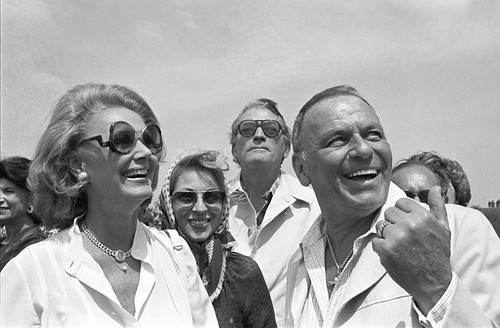
Frank and Barbara Sinatra wearing her Bulgari necklace with 1857 $1 gold
Jewellery senior specialist at Sotheby's Carol Elkins last December took care of the sale of a platinum and diamonds Bulgari necklace set with an 1857 United States $1 gold coin belonging to Barbara Sinatra. It sold for $62,500 against an estimate of $20,000. "Judging from the sales at auction of coin jewellery, I'd say there's definitely a renewed interest in the genre," says Elkins who says the style appeals to a broad audience because "they have an interesting look, show cultural heritage and are interesting pieces of conversation".
To read the complete article, see:
Coining it in: the rise of numismatic jewellery
(https://www.ft.com/content/4b5173e6-6b4e-11e9-80c7-60ee53e6681d)
THE BOOK BAZARRE
LOOSE CHANGE: MAY 19, 2019
Here are some additional items from the media this week that may be of interest. -Editor
American Eagle artists interviewed
A May 17, 2019 Coin World article by Paul Gilkes interviews creators of the American Eagle bullion coin designs on the Mint's plans to redesign the pieces. -Editor
The designers of the reverses of the American Eagle gold and silver bullion coins have mixed opinions about the possibility that their designs might be replaced with new ones, as U.S. Mint officials are proposing. The same designs have been on the coins since both series were introduced in the fall of 1986 - a design by Miley Busiek Frost on the gold coin and one by John Mercanti on the silver coin.
Mercanti, who retired in 2010 as the nation's 12th chief engraver, says changing the American Eagle designs is inevitable. "Nothing lasts forever," he said matter-of-factly.
Frost, however, has a very different view on the possibility of a new design. The private-sector sculptor who designed the Family of Eagles motif for the reverse of the gold series, questions the U.S. Mint's logic in replacing the designs of one of the world's most recognizable and best-selling gold bullion coins.
To read the complete article, see:
American Eagle artists speak
out on possible replacement of designs
(https://www.coinworld.com/news/precious-metals/2019/05/american-eagle-coin-artists-comment-on-redesign.html)
Buyer's Fee Math
This New York Times article is about the art world, but numismatists know a thing or two about auction house buyer's fees, and this math doesn't add up. -Editor
Jeff Koons is back on top, if on top means holding the highest auction price for a living artist, as hyped by the auction house responsible. Mr. Koons's 1986 "Rabbit," a precise stainless steel copy of a plastic inflatable toy - mirror-smooth yet with seams and puckers - sold Wednesday night at Christie's Post-War and Contemporary Art sale for $91.1 million, the highlight of New York's buoyant spring auctions.
It broke the record set last fall when Christie's auctioned David Hockney's "Portrait of an Artist (Pool With Two Figures)" - a 1972 painting the size of a small mural - for $90.3 million. But let's get real. The hammer price for both works was actually $80 million. The "Rabbit" inched ahead by a whisker - about $762,500 - because of a twist of fate: Christie's increased the fees buyers pay on Feb. 1. The difference was simply a matter of auction house profit-seeking. It recalls the soaring home-run statistics from baseball's "steroid era" before testing for performance enhancing drugs became routine. The price should have an asterisk or footnote - something that says, hey, the final bids on these two art works were exactly the same. It was a tie.
Yes, the hammer price is the same, but who cares? It doesn't matter. The buyer doesn't pay the hammer price, they pay the hammer PLUS the buyer's fee, so the latest work sold for More. Real. Money. That's what matters.
I guess another way to look at it is from the seller's viewpoint. Assuming seller's fees were the same in both cases, then the sellers collected the same amount, and you could say the pieces "sold" for the same amount. But the buyer's fees are real and you can't just pretend they don't exist. A thing is worth what someone else will pay for it, and what the buyers paid includes that pesky buyer's fee,
-Editor
To read the complete article, see:
Stop Hating Jeff Koons
(https://www.nytimes.com/2019/05/17/arts/jeff-koons-auction-christies.html)
Stolen 1780 Hamilton Letter Found
Bibliophiles and researchers alike should enjoy this New York Times report that an important long-missing 1780 letter by Alexander Hamilton stolen from the Massachusetts Archives has been found after some 70 years. Thanks to Len Augsburger for spotting this story. -Editor
 A letter written by Alexander Hamilton during the Revolutionary War has resurfaced more than seven decades after the document was stolen
from the Massachusetts Archives, according to federal authorities.
A letter written by Alexander Hamilton during the Revolutionary War has resurfaced more than seven decades after the document was stolen
from the Massachusetts Archives, according to federal authorities.
The letter, addressed to Hamilton's good friend the Marquis de Lafayette, came to light last November when an auction house in Virginia notified the F.B.I. after a South Carolina family tried to consign it for auction, according to a complaint filed Wednesday in Federal District Court in Massachusetts by the United States District Attorney's Office.
In 1950, a former Massachusetts Archives employee was arrested for stealing and selling documents, including the Hamilton letter and original papers of George Washington, Benjamin Franklin and other founding fathers, to rare-books dealers when he worked at that institution between 1937 and 1945, the complaint stated.
The three-paragraph letter - now valued between $25,000 and $35,000, according to the Virginia auction house - warned Lafayette, the French general who commanded troops in several Revolutionary War battles, of pending danger from the British.
To read the complete article, see:
A Stolen Letter Written by Alexander Hamilton in 1780 Resurfaces
(https://www.nytimes.com/2019/05/18/us/alexander-hamilton-letter.html)
Amazing Circus Poster Find in Wisconsin
It's non-numismatic, but the researchers and ephemera collectors among us will enjoy this amazing story of archival preservation. It's worth reading the whole thing online. Thanks to Len Augsburger for passing along this story from the Chicago Tribune. -Editor
By the time Berger was done excavating and researching, he had unearthed a 9-foot-high by 55-foot-long, multi-sheet, full-color paper lithograph circus poster advertising the Great Anglo-American Circus and Menagerie performing in Durand on Aug. 17, 1885, according to the Eau Claire Leader-Telegram.
"It's one of the oldest and best preserved circus posters in the world," Berger said. "It's considered a one-and-only type of thing."
"Circuses, in their day, were pioneers of mass media and in-your-face, bombastic advertising," he said. "That bill stand is really a perfect example of that kind of approach."
To read the complete article, see:
Wisconsin bar owner uncovers huge,
134-year-old circus poster: 'It should never have survived'
(https://www.chicagotribune.com/nation-world/ct-wisconsin-old-circus-poster-20190515-story.html)
New Website: Bookophile
For bibliophiles there's a new web site devoted to books. I haven't seen a numismatic book there yet, but those may come in the future. Here's what dealer Shanna Schmidt had to say about it in her Newsletter #116. -Editor
I'm so excited to see that the folks from Coinsweekly have endeavored to create a new website which features books, one of my favorite things. Bookophile is a beautifully designed site with articles and more on interesting books and relatable subjects. I'm sure this is a work in progress but from what I've seen thus far I believe I will be visiting this very often.
Here is a link to it. The site is available in English and German.
https://bookophile.com/?lang=en
BIG BANG THEORY'S FAKE NOBEL PRIZE MEDAL
Mel Wacks submitted this article on the prop Nobel Prize medal awarded in the final episode of the TV show The Big Bang Theory. Thanks! Mel, you deserve a medal! -Editor
Fake Nobel Prize Medal Presented to Dr. Amy Farrah Fowler and Sheldon Cooper on Final Episode of The Big Bang Theory

Did you happen to notice that the Nobel Prize medal awarded to Dr. Amy Farrah Fowler and Dr. Sheldon Cooper on the final episode of The Big Bang Theory was not what a real Nobel Prize medal looks like? I would guess that there was a copyright problem that prevented the real medal from being pictured. The Big Bang Nobel Prize medal has an entirely different portrait of Alfred Nobel. His birth year is indicated as MDCCCXXXII instead of MDCCCXXXIII on the actual medal, and the year of his death is indicated as MDCCCXCIV rather than MDCCCXCVI on the genuine Nobel Prize medal.

Nobel Prize medal awarded to Amy and Sheldon Cooper on the final episode of The Big Bang Theory
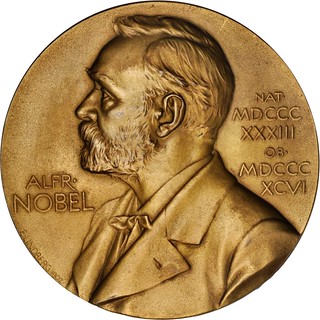
Actual Nobel Prize medal for Physics
FEATURED WEB SITE: CANADIAN TIRE COUPON COLLECTORS CLUB
This week's Featured Web Site is the Canadian Tire Coupon Collectors Club
The CTCCC was founded in September of 1990, at the final Toronto International Coin Fair. The meeting received a publicity boost from a Globe and Mail article that reported the possible demise of the Canadian Tire cash bonus coupon. This then resulted in a media blitz that demonstrated how little was known about Canada's second currency'.
As the club grew, it developed a professionally produced quarterly newsletter reporting discoveries and information about varieties and issues. The CTCCC was the first fully bilingual numismatic club in Canada, offering members a choice of an English or French newsletter. Meetings are held in conjunction with mainstream coin shows across Canada, from Vancouver to St. John's, with many other regional meetings at smaller coin shows. Where appropriate, meetings are simultaneously translated for members.
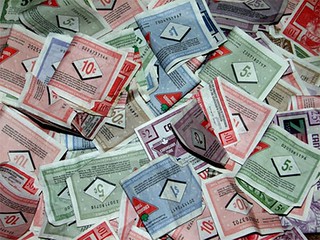
https://www.ctccc.ca/

